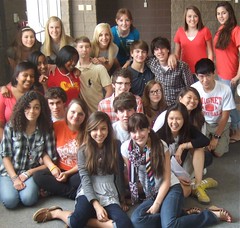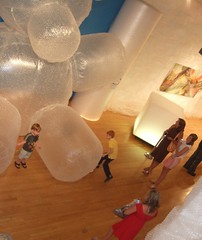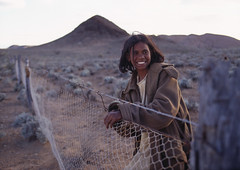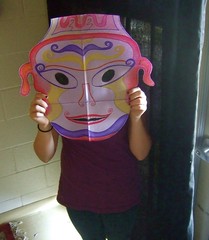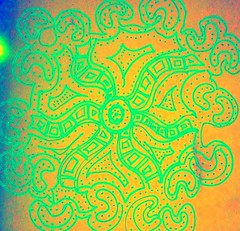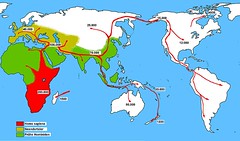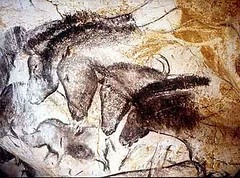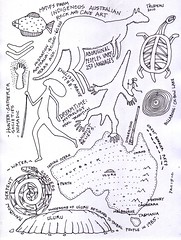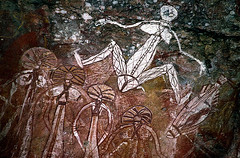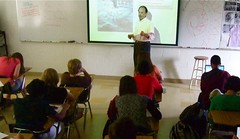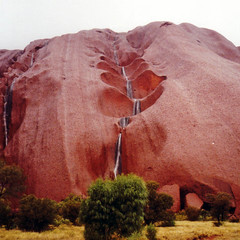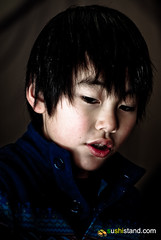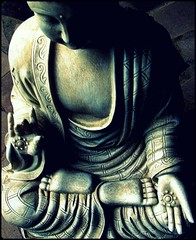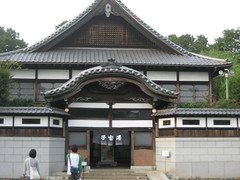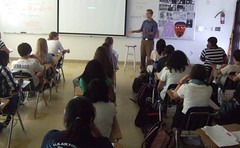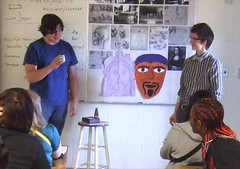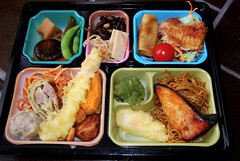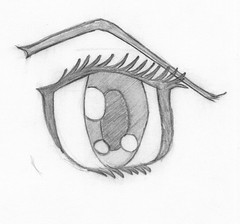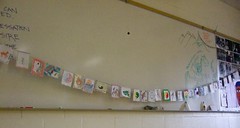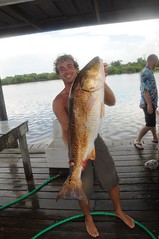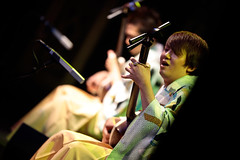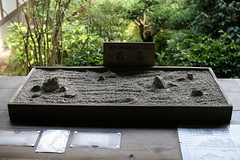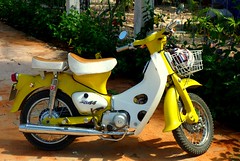Wall Street has called the end of an era and the beginning of the next one: The most important technology product no longer sits on your desk but rather fits in your hand. So says a report in the NY Times.
The moment came Wednesday when Apple, the maker of iPods, iPhones and iPads, shot past Microsoft, the computer software giant, to become the world’s most valuable technology company.
This changing of the guard caps one of the most stunning turnarounds in business history for Apple, which had been given up for dead only a decade earlier, and its co-founder and visionary chief executive, Steven P. Jobs. The rapidly rising value attached to Apple by investors also heralds an important cultural shift: Consumer tastes have overtaken the needs of business as the leading force shaping technology.
Microsoft, with its Windows and Office software franchises, has dominated the relationship most people had with their computers for almost two decades, and that was reflected in its stock market capitalization. But the click-clack of the keyboard has ceded ground to the swipe of a finger across a smartphone’s touch screen.
And Apple is in the right place at the right time. Although it still sells computers, twice as much revenue is coming from hand-held devices and music. Over all, the technology industry sold about 172 million smartphones last year, compared with 306 million PCs, but smartphone sales grew at a pace five times faster.
See more of the article on your iPhone or Macbook or iPad.
Wednesday, May 26, 2010
Monday, May 24, 2010
Semester exam: 100 multiple choice questions
Open notes exam on tests from this semester - as posted below.
Questions will be based on those in each of the sections below:
- Africa, etc
- Demographics, etc
- Caribbean, etc
- Climate change, etc
- Exam review, 70 questions
Questions may be tweaked so as to provide a challenge in the target skill of reading comprehension.
How to prepare -
1. print out the questions.
2. read and understand the questions.
3. highlight issues and questions you know are likely to appear on the test.
4. bring your atlas as backup.
The 10 pt. constructed response - essay part - is explained below.
Questions will be based on those in each of the sections below:
- Africa, etc
- Demographics, etc
- Caribbean, etc
- Climate change, etc
- Exam review, 70 questions
Questions may be tweaked so as to provide a challenge in the target skill of reading comprehension.
How to prepare -
1. print out the questions.
2. read and understand the questions.
3. highlight issues and questions you know are likely to appear on the test.
4. bring your atlas as backup.
The 10 pt. constructed response - essay part - is explained below.
Constructed response on the semester exams
Brief!
Key is to hit these guidelines -
- Vivid opening - Vrrrrnnnndggggnnggghhhhhh
- Blend the topics - integrate the material
- Generalities are cheap - be specific - be detailed - 60 million sold worldwide!
- Documentation
- Snappy titling
- Grammar and spelling
Choose a topic -
Honda Super Cub and the Model T
Maria Montessori and Madonna
Madonna and Lady Gaga
Google and Apple
Sergei Brin and Larry Page / Steve Jobs
Key is to hit these guidelines -
- Vivid opening - Vrrrrnnnndggggnnggghhhhhh
- Blend the topics - integrate the material
- Generalities are cheap - be specific - be detailed - 60 million sold worldwide!
- Documentation
- Snappy titling
- Grammar and spelling
Choose a topic -
Honda Super Cub and the Model T
Maria Montessori and Madonna
Madonna and Lady Gaga
Google and Apple
Sergei Brin and Larry Page / Steve Jobs
Sunday, May 23, 2010
Continent of Africa, continent of Africa quiz and Lost Boys of Sudan quiz
Africa review
1. Morocco: a) Mediterranean Africa b) West Africa
c) East Africa.
2. Ghana: a) Mediterranean Africa b) West Africa
c) East Africa.
3. South Africa: a) Mediterranean Africa b) West Africa
c) East Africa.
4. Nigeria: a) Mediterranean Africa b) West Africa
c) East Africa.
5. Sudan: a) Mediterranean Africa b) West Africa
c) East Africa.
6. Tunisia: a) Mediterranean Africa b) West Africa
c) East Africa.
7. Symbol employed by Mexican Catholics in prayer for healing: a) sudan b) relief c) slave beads d) milagro.
8. Moroccan traveler of the 1300’s who wrote a book of his extensive journeys: a) Ibn Battuta b) Richard Burton
c) John Speke d) Marco Polo.
9. British explorer associated with the search for the source of the Nile River. Was also an author and expert in languages of Africa and Asia. a) Ibn Battuta b) Richard Burton c) John Speke d) Marco Polo.
10. Tribe of Ghana, formerly known as the Gold Coast:
a) Kakuma b) Dinka c) Ashanti d) Djembe.
11. Tribe of the Nile region of Southern Sudan: a) Kakuma b) Dinka c) Ashanti d) Djembe.
12. Arabic is a major component of this African language:
a) Bantu b) Swahili c) Ashanti d) Wolof.
13. Which are the indigenous people of Zanzibar? a) Arabs b) Europeans c) Swahili d) Africans.
14. Sudan is divided in the middle by the a) equator
b) Arabic-Tribal border c) Nile River d) Sahara Desert.
15. The first outside group to trade with West Africans for gold, ivory and slaves: a) Arabs b) Europeans c) Romans d) Swahili.
16. Languages spoken by Sudanese refugee Peter Dut in the documentary Lost Boys of Sudan: a) Dinka, Arabic,
English, Swahili b) Dinka, Arabic, French, English
c) Dinka, Arabic, English.
17. The Dinka tribe of Southern Sudan were being persecuted partly based on their religion: a) Christian
b) Muslim c) Jewish d) Indigenous.
18. The African instrument described as a thumb piano
is also called a a) shekere b) kora c) bongo d) kalimba.
19. West African nation associated with freed American slaves: a) Ghana b) Liberia c) Senegal d) Nigeria.
20. A basic African dish which is a paste made by pounding a potato-like plant: a) banku b) fufu
c) plaintain d) felafel.
21. American mogul who has become a philanthropist with
a mission that includes infectious diseases of Africa:
a) Steve Jobs b) Sumner Redstone c) Bill Gates d) Dick Cheney.
22. Percentage of African-American population in the US:
a) 3% b) 13% c) 33% d) 43%.
23. A source for the mineral called ColTan, used in miniaturized batteries: a) Congo b) Egypt c) South Africa
d) Morocco.
24. River that originates in the mountains of Ethiopia:
a) Blue Nile b) White Nile c) Mountain Nile d) Victoria.
25. Lake that is the source of the Nile: a) Victoria
b) Tanganyika c) Tana d) Aswan.
26. Valuable resource that in West Africa and other regions has led to development of militias of child soldiers:
a) gold b) diamonds c) oil d) ivory.
27. Arabic vessel associated with trade across the Indian Ocean: a) dhow b) kalimba c) milagro d) brig.
28. Zanzibar was a historically independent nation; today it is part of a) Kenya b) India c) Dar es Salaam d) Tanzania.
29. Marine organisms that are important reef builders:
a) octopus b) lobster c) coral d) seaweed.
30. In geographic terminology the difference in elevation is called a) relief b) terrain c) irregularity d) ridging.
31. Peter and Santino left the violence in Sudan for a refugee camp in a) Kenya b) Tanzania c) Uganda
d) Nigeria.
32. A film that is based on actual dialogue and action that is captured as events unfold is called a a) drama
b) promotion c) documentary d) docu-drama.
33. The demographic rank of US city via their populations: a) NYC, Los Angeles, Chicago, Houston
b) NYC, Chicago, Los Angeles, Houston
c) Los Angeles, NYC, Chicago, Houston
34. The Indian Ocean trade route spanned India to Africa with __ in between. a) Persia b) Arabia c) Egypt
d) Afghanistan.
35. Elements of the Atlantic Trade Triangle, which resulted in a diaspora of African peoples, included West Africa, the US colonies, Europe and the __ . a) Mediterranean b) Arabian Sea c) Caribbean d) India
1. Mediterranean 2. West 3. East 4. West 5. East 6. Med 7. milagro
8. Ibn Battuta 9. Burton 10. Ashanti 11. Dinka 12. Swahili 13. Africans
14. Nile 15. Arabs 16. Dinka, Arabic, English, Swahili 17. Christian
18. kalimba 19. Liberia 20. fufu 21. Gates 22. 13% 23. Congo 24. Blue Nile 25. Victoria 26. diamonds 27. dhow 28. Tanzania 29. coral 30. relief
31. Kemya 32. documentary 33. NYC, LA, Chicago, Houston
34. Arabia 35. Caribbean
Lost Boys of Sudan
1. Lost Boys of Sudan presents political, social, or historical subject matter in a factual and informative manner. Thus we call it a a) drama b) documentary c) reality TV d) direct TV.
2. Bienvenue: a) good luck! b) get well! c) good eating! d) welcome!
3. Demographics is the study of a) populations b) nations c) cities d) ethnic groups.
4. A large organization marked by many layers of authority (such as a government or a school system): a) bureaucracy b) documentary c) benign d) effluvia.
5. An acacia is an African a) plain b) tree c) village d) hut.
6. Name the connection between Ethiopia and Sudan as well as between Lake Victoria and the Mediterranean: a) Islam
b) poverty c) the Nile d) ancient caravan routes.
7. The Upper Nile is in a) southern Egypt b) southern Egypt c) western Egypt.
8. A memory aid: a) acronym b) mnemonic c) ululation.
9. Swahili is the language of a) East Africa b) Mediterranean Africa c) Madagascar
d) Sudan.
10. Population of metropolitan Houston: a) 2.5 M b) 5.7 M
c) 11.5 M d) 40.5 M.
11. The Red River flows through North Louisiana thusly: a) NW to SE b) E to W c) W to E d) SE to NW.
12. In ancient history, which came first to Sudan? a) Christianity
b) Islam c) Buddhism.
13. Just as Sudan's civil war seemed to be coming to an end, another genocidal massacre intensified in the northwestern region of __ .
a) Darfur b) Khartoum c) Libya d) Dinka territory.
14. That the British were colonial masters of Sudan for 150 years is implied by the profile of the nation. You will find a hint in the people’s a) racial characteristics b) languages c) occupations d) educational system.
15. Things that are native to a region are said to be a) indigent
b) indigenous c) inveterate d) individual.
16. Silicon valley is near a) Seattle b) San Francisco c) Los Angeles d) San Diego.
17. Bill Gates’ home and Microsoft world headquarters is in the state of a) Oregon b) California c) Washington d) Texas.
18. Haiti and Dominican Republic are two poor nations on one island: a) Puerto Rico b) Hispaniola c) Cayman Is. d) Port-au-Prince.
19. A chain of islands is referred to as an a) archipelago b) strait
c) alluvial chain d) asylum.
20. Equal day and night: a) equinox b) solstice c) synonymous.
21. Which would produce the longest day of the year? a) summer solstice b) winter solstice c) fall equinox d) spring equinox.
22. Name the ocean current with the greatest impact on Louisiana: a) Gulf of Mexico b) Caribbean c) Gulf Stream d) Labrador Current.
1. documentary 2. welcome 3. populations 4. bureaucracy 5. tree
6. Nile 7. southern Egypt 8. mnemonic 9. E Af 10. 5.7 m 11. NW to SE
12. Islam 13. Darfur 14. language 15. indigenous 16. San Francisco/San Jose
17. Wash; neat Seattle 18. Hispaniola 19. archipelago 20. equinox 21. summer solstice 22. Gulf Stream
1. Morocco: a) Mediterranean Africa b) West Africa
c) East Africa.
2. Ghana: a) Mediterranean Africa b) West Africa
c) East Africa.
3. South Africa: a) Mediterranean Africa b) West Africa
c) East Africa.
4. Nigeria: a) Mediterranean Africa b) West Africa
c) East Africa.
5. Sudan: a) Mediterranean Africa b) West Africa
c) East Africa.
6. Tunisia: a) Mediterranean Africa b) West Africa
c) East Africa.
7. Symbol employed by Mexican Catholics in prayer for healing: a) sudan b) relief c) slave beads d) milagro.
8. Moroccan traveler of the 1300’s who wrote a book of his extensive journeys: a) Ibn Battuta b) Richard Burton
c) John Speke d) Marco Polo.
9. British explorer associated with the search for the source of the Nile River. Was also an author and expert in languages of Africa and Asia. a) Ibn Battuta b) Richard Burton c) John Speke d) Marco Polo.
10. Tribe of Ghana, formerly known as the Gold Coast:
a) Kakuma b) Dinka c) Ashanti d) Djembe.
11. Tribe of the Nile region of Southern Sudan: a) Kakuma b) Dinka c) Ashanti d) Djembe.
12. Arabic is a major component of this African language:
a) Bantu b) Swahili c) Ashanti d) Wolof.
13. Which are the indigenous people of Zanzibar? a) Arabs b) Europeans c) Swahili d) Africans.
14. Sudan is divided in the middle by the a) equator
b) Arabic-Tribal border c) Nile River d) Sahara Desert.
15. The first outside group to trade with West Africans for gold, ivory and slaves: a) Arabs b) Europeans c) Romans d) Swahili.
16. Languages spoken by Sudanese refugee Peter Dut in the documentary Lost Boys of Sudan: a) Dinka, Arabic,
English, Swahili b) Dinka, Arabic, French, English
c) Dinka, Arabic, English.
17. The Dinka tribe of Southern Sudan were being persecuted partly based on their religion: a) Christian
b) Muslim c) Jewish d) Indigenous.
18. The African instrument described as a thumb piano
is also called a a) shekere b) kora c) bongo d) kalimba.
19. West African nation associated with freed American slaves: a) Ghana b) Liberia c) Senegal d) Nigeria.
20. A basic African dish which is a paste made by pounding a potato-like plant: a) banku b) fufu
c) plaintain d) felafel.
21. American mogul who has become a philanthropist with
a mission that includes infectious diseases of Africa:
a) Steve Jobs b) Sumner Redstone c) Bill Gates d) Dick Cheney.
22. Percentage of African-American population in the US:
a) 3% b) 13% c) 33% d) 43%.
23. A source for the mineral called ColTan, used in miniaturized batteries: a) Congo b) Egypt c) South Africa
d) Morocco.
24. River that originates in the mountains of Ethiopia:
a) Blue Nile b) White Nile c) Mountain Nile d) Victoria.
25. Lake that is the source of the Nile: a) Victoria
b) Tanganyika c) Tana d) Aswan.
26. Valuable resource that in West Africa and other regions has led to development of militias of child soldiers:
a) gold b) diamonds c) oil d) ivory.
27. Arabic vessel associated with trade across the Indian Ocean: a) dhow b) kalimba c) milagro d) brig.
28. Zanzibar was a historically independent nation; today it is part of a) Kenya b) India c) Dar es Salaam d) Tanzania.
29. Marine organisms that are important reef builders:
a) octopus b) lobster c) coral d) seaweed.
30. In geographic terminology the difference in elevation is called a) relief b) terrain c) irregularity d) ridging.
31. Peter and Santino left the violence in Sudan for a refugee camp in a) Kenya b) Tanzania c) Uganda
d) Nigeria.
32. A film that is based on actual dialogue and action that is captured as events unfold is called a a) drama
b) promotion c) documentary d) docu-drama.
33. The demographic rank of US city via their populations: a) NYC, Los Angeles, Chicago, Houston
b) NYC, Chicago, Los Angeles, Houston
c) Los Angeles, NYC, Chicago, Houston
34. The Indian Ocean trade route spanned India to Africa with __ in between. a) Persia b) Arabia c) Egypt
d) Afghanistan.
35. Elements of the Atlantic Trade Triangle, which resulted in a diaspora of African peoples, included West Africa, the US colonies, Europe and the __ . a) Mediterranean b) Arabian Sea c) Caribbean d) India
1. Mediterranean 2. West 3. East 4. West 5. East 6. Med 7. milagro
8. Ibn Battuta 9. Burton 10. Ashanti 11. Dinka 12. Swahili 13. Africans
14. Nile 15. Arabs 16. Dinka, Arabic, English, Swahili 17. Christian
18. kalimba 19. Liberia 20. fufu 21. Gates 22. 13% 23. Congo 24. Blue Nile 25. Victoria 26. diamonds 27. dhow 28. Tanzania 29. coral 30. relief
31. Kemya 32. documentary 33. NYC, LA, Chicago, Houston
34. Arabia 35. Caribbean
Lost Boys of Sudan
1. Lost Boys of Sudan presents political, social, or historical subject matter in a factual and informative manner. Thus we call it a a) drama b) documentary c) reality TV d) direct TV.
2. Bienvenue: a) good luck! b) get well! c) good eating! d) welcome!
3. Demographics is the study of a) populations b) nations c) cities d) ethnic groups.
4. A large organization marked by many layers of authority (such as a government or a school system): a) bureaucracy b) documentary c) benign d) effluvia.
5. An acacia is an African a) plain b) tree c) village d) hut.
6. Name the connection between Ethiopia and Sudan as well as between Lake Victoria and the Mediterranean: a) Islam
b) poverty c) the Nile d) ancient caravan routes.
7. The Upper Nile is in a) southern Egypt b) southern Egypt c) western Egypt.
8. A memory aid: a) acronym b) mnemonic c) ululation.
9. Swahili is the language of a) East Africa b) Mediterranean Africa c) Madagascar
d) Sudan.
10. Population of metropolitan Houston: a) 2.5 M b) 5.7 M
c) 11.5 M d) 40.5 M.
11. The Red River flows through North Louisiana thusly: a) NW to SE b) E to W c) W to E d) SE to NW.
12. In ancient history, which came first to Sudan? a) Christianity
b) Islam c) Buddhism.
13. Just as Sudan's civil war seemed to be coming to an end, another genocidal massacre intensified in the northwestern region of __ .
a) Darfur b) Khartoum c) Libya d) Dinka territory.
14. That the British were colonial masters of Sudan for 150 years is implied by the profile of the nation. You will find a hint in the people’s a) racial characteristics b) languages c) occupations d) educational system.
15. Things that are native to a region are said to be a) indigent
b) indigenous c) inveterate d) individual.
16. Silicon valley is near a) Seattle b) San Francisco c) Los Angeles d) San Diego.
17. Bill Gates’ home and Microsoft world headquarters is in the state of a) Oregon b) California c) Washington d) Texas.
18. Haiti and Dominican Republic are two poor nations on one island: a) Puerto Rico b) Hispaniola c) Cayman Is. d) Port-au-Prince.
19. A chain of islands is referred to as an a) archipelago b) strait
c) alluvial chain d) asylum.
20. Equal day and night: a) equinox b) solstice c) synonymous.
21. Which would produce the longest day of the year? a) summer solstice b) winter solstice c) fall equinox d) spring equinox.
22. Name the ocean current with the greatest impact on Louisiana: a) Gulf of Mexico b) Caribbean c) Gulf Stream d) Labrador Current.
1. documentary 2. welcome 3. populations 4. bureaucracy 5. tree
6. Nile 7. southern Egypt 8. mnemonic 9. E Af 10. 5.7 m 11. NW to SE
12. Islam 13. Darfur 14. language 15. indigenous 16. San Francisco/San Jose
17. Wash; neat Seattle 18. Hispaniola 19. archipelago 20. equinox 21. summer solstice 22. Gulf Stream
Demographics and topical issues quizzes
C 1. Native to and occurring naturally in an area. a) indigent b) indiginal c) indigenous d) indigital.
A 2. Arabic greeting; "Peace!" a) Salaam b) Ramadan c) Shalom d) Ciao.
A 3. Jersey is one of the Channel Islands on the coast of Normandy, France. It is owned by the a) British
b) French c) Irish d) Belgians.
D 4. The remaining piece of the US Ethnic Population circle graph, according to the US Census Bureau, after
giving slices to Hispanics, African-Americans, Asians, American Indians and other minority groups: a) 19%
b) 44% c) 66% d) 74%.
B 5. New Orleanians refer to suburbs such as Kenner as being on the West Bank. Decide whether the French Quarter is on the a) West Bank or b) East Bank.
B 6. The damage to New Orleans during Hurricane Katrina was due mostly to a) wind damage b) levee failure
c) loss of wetlands d) catastrophic conditions.
A 7. Because of its rivers and widespread deposits of alluvial soil, Louisiana has developed much of its wealth through a) agriculture b) petroleum c) seafood d) history.
C 8. A landlocked, mountainous nation in which the Taliban once sheltered the operations of al Qaeda.
a) Iran b) Iraq c) Afghanistan d) Pakistan.
B 9. Most directly associated with the 9/11 attacks: a) Taliban b) al Qaeda c) Afghanis d) Arabians.
A 10. a) Henry Hudson b) Hernan DeSoto c) Lewis and Clark: Which exploring group opened the Atlantic rim to trade and development?
A 11. A) Conservative b) liberal: strongly supports lower taxes.
A 12. A) Conservative b) liberal: strongly against government regulations that control the economy.
Haiti and topical issues quiz
1. Name the 2 leaders of Russia today.
2. Technically, Russia is a democracy. Yet a different type kind of
governmental attitude is implied in the animation story. What type
govt do the Russians, in effect, have?
3. Recent research implies that the dominant force in good manners
(p4) may be a) inborn trait b) parental training c) school-based
instruction.
4. Cyber ninjas: what field would you enter if you wanted to help
business and govt defend against felonious hackers?
5. Julius Caesar had his greatest success in Gaul, which is today's
nations of __ and __ . There he led Roman forces to a long hoped-for
victory over the a) Celts b) Germanic forces c) Slavs.
6. When Caesar became the emperor, he came under the suspicion of
members of the Roman Senate. Worried that he would become a dictator,
the group assassinated him. That took place in 44 BCE, in the nation
of __, in the city of __ .
7. It is estimated that your classmates spend about __ hours per day
on digital devices.
8. Have you checked your average daily usage of electonic-type units?
Your guesstimate: __ hours.
9. One reason sushi is not a cheap supper? In other words, what's an
example of the price per pound for tuna in the Tokyo fish market?
1o. The funny thing is, you cannot tell the height of people appearing
on the Tv screen. Yet prosperous South Koreans are worried. What's the
story?
11. The Burj Khalifa is located in __. It towers over the __ Gulf.
12. The Burj is taller than the former World Trade Center. It is
almost __ as tall. a) one-fourth b) one third c) twice.
13. Sketch a fresh map of the neighbors of Haiti. Identify 5 land
bodies and 3 seas.
14. On the map, list 5 descriptions of the earthquake's impact.
15. List 3 practical reasons that motivate the US rescue attempts.
16. Timeline Haiti: importantly, there was a 30-year period of
exploitation that was led by __ __ and his son, __ __ .
17. Name 8 major companies that have recently sued each other over
false advertising.
18. What government unit tries to enforce complaints in regards false ads?
19. "Hyperbole and illusion are predictable products of a capitalist,
consumer society." Translate or define the 4 key words.
20. South Africa experienced a major upheaval in the year __, when the
government allowed changes that led to the freedom of fabled protest
leader __ __.
21. Disassembly of the the racist system called __ extended voting
rights and other civil rights to people of the category termed __ .
22. South Africa's top difficulties today: __ unemployment; __ in
poverty; __ of the population diagnosed with HIV; high rates of __
crime.
23. S. Af's worst problem is educational achievement. Its drop-out
rate: __ of students do not graduate from secondary school.
Tues: Cutting. coloring, pasting and annotating the Monuments of Paris
map project. Followed by a comparison-based Monuments of London project. Same method and criteria.
Answers -
1. Vladimir Putin, PM, and Dmitri Medvedev, president.
2. Dictatorship. More technically, they have an oligarchy.
An oligarchy, says Wikipedia, is a form of government in which power effectively rests with a small elite segment of society distinguished by royalty, wealth, intellect, family ties, military might, or religion hegemony. The word oligarchy is from the Greek words for "few" (ὀλίγος olígos) and "rule" (ἀρχή arkhē). Such states are often controlled by politically powerful families whose children are heavily conditioned and mentored to be heirs of the power of the oligarchy.
Oligarchies have been tyrannical throughout history, being completely reliant on public servitude to exist. Although Aristotle pioneered the use of the term as a synonym for rule by the rich, for which the exact term is plutocracy, oligarchy is not always a rule by wealth, as oligarchs can simply be a privileged group. Some city-states from ancient Greece were oligarchies. The combination of the words plutocracy and oligarchy make the word plutarchy.
3. A; largely inborn.
4. Careers? computer security
5. France, Belgium, a) Celts
6. Rome, Italy
7. digital usage: 7.5 hours
8. 4 hrs
9. Japanese tuna: $3,450 per lb.
10. S Koreans are sending kids to growth clinics in attempts to produce taller offspring.
11. Burj Khalifa: Dubai. Persian Gulf.
12. c; twice as tall
13. Hispaniola, Dominican Republic, Puerto Rico, Bahamas, Florida, Cuba, Jamaica; Gulf of Mexico, Caribbean, Atlantic.
14. a) Earthquake killed several hundred thousand, injured more. b) millions homeless. c) Port-au- Prince, city of 2 million, leveled. d) overwhelmed the govt. e) illegal immigrants flee to US.
15. Prevent large illegal migration, humanitarian reasons, in best interests of US for future.
16. Dictator Papa Doc Duvalier, Baby Doc Duvalier, 1956 - 1986.
17. ATT vs Verizon, Campbell's vs Progresso, Dove vs Pantene, Sci Diet vs Iams.
18. The FTC, Fed Trade Commission.
19. hyperbole: exaggeration;
illusion, falsely appears to exist;
capitalist, free market;
consumer, based on choices by people who purchase.
20. 1990 - 91; Nelson Mandela.
21. apartheid, Bantu or Colored.
22. S Af: 25% unemployment; 50% in poverty; 14% of the population diagnosed with HIV; high rates of violent crime.
23. 50% drop-out rate.
A 2. Arabic greeting; "Peace!" a) Salaam b) Ramadan c) Shalom d) Ciao.
A 3. Jersey is one of the Channel Islands on the coast of Normandy, France. It is owned by the a) British
b) French c) Irish d) Belgians.
D 4. The remaining piece of the US Ethnic Population circle graph, according to the US Census Bureau, after
giving slices to Hispanics, African-Americans, Asians, American Indians and other minority groups: a) 19%
b) 44% c) 66% d) 74%.
B 5. New Orleanians refer to suburbs such as Kenner as being on the West Bank. Decide whether the French Quarter is on the a) West Bank or b) East Bank.
B 6. The damage to New Orleans during Hurricane Katrina was due mostly to a) wind damage b) levee failure
c) loss of wetlands d) catastrophic conditions.
A 7. Because of its rivers and widespread deposits of alluvial soil, Louisiana has developed much of its wealth through a) agriculture b) petroleum c) seafood d) history.
C 8. A landlocked, mountainous nation in which the Taliban once sheltered the operations of al Qaeda.
a) Iran b) Iraq c) Afghanistan d) Pakistan.
B 9. Most directly associated with the 9/11 attacks: a) Taliban b) al Qaeda c) Afghanis d) Arabians.
A 10. a) Henry Hudson b) Hernan DeSoto c) Lewis and Clark: Which exploring group opened the Atlantic rim to trade and development?
A 11. A) Conservative b) liberal: strongly supports lower taxes.
A 12. A) Conservative b) liberal: strongly against government regulations that control the economy.
Haiti and topical issues quiz
1. Name the 2 leaders of Russia today.
2. Technically, Russia is a democracy. Yet a different type kind of
governmental attitude is implied in the animation story. What type
govt do the Russians, in effect, have?
3. Recent research implies that the dominant force in good manners
(p4) may be a) inborn trait b) parental training c) school-based
instruction.
4. Cyber ninjas: what field would you enter if you wanted to help
business and govt defend against felonious hackers?
5. Julius Caesar had his greatest success in Gaul, which is today's
nations of __ and __ . There he led Roman forces to a long hoped-for
victory over the a) Celts b) Germanic forces c) Slavs.
6. When Caesar became the emperor, he came under the suspicion of
members of the Roman Senate. Worried that he would become a dictator,
the group assassinated him. That took place in 44 BCE, in the nation
of __, in the city of __ .
7. It is estimated that your classmates spend about __ hours per day
on digital devices.
8. Have you checked your average daily usage of electonic-type units?
Your guesstimate: __ hours.
9. One reason sushi is not a cheap supper? In other words, what's an
example of the price per pound for tuna in the Tokyo fish market?
1o. The funny thing is, you cannot tell the height of people appearing
on the Tv screen. Yet prosperous South Koreans are worried. What's the
story?
11. The Burj Khalifa is located in __. It towers over the __ Gulf.
12. The Burj is taller than the former World Trade Center. It is
almost __ as tall. a) one-fourth b) one third c) twice.
13. Sketch a fresh map of the neighbors of Haiti. Identify 5 land
bodies and 3 seas.
14. On the map, list 5 descriptions of the earthquake's impact.
15. List 3 practical reasons that motivate the US rescue attempts.
16. Timeline Haiti: importantly, there was a 30-year period of
exploitation that was led by __ __ and his son, __ __ .
17. Name 8 major companies that have recently sued each other over
false advertising.
18. What government unit tries to enforce complaints in regards false ads?
19. "Hyperbole and illusion are predictable products of a capitalist,
consumer society." Translate or define the 4 key words.
20. South Africa experienced a major upheaval in the year __, when the
government allowed changes that led to the freedom of fabled protest
leader __ __.
21. Disassembly of the the racist system called __ extended voting
rights and other civil rights to people of the category termed __ .
22. South Africa's top difficulties today: __ unemployment; __ in
poverty; __ of the population diagnosed with HIV; high rates of __
crime.
23. S. Af's worst problem is educational achievement. Its drop-out
rate: __ of students do not graduate from secondary school.
Tues: Cutting. coloring, pasting and annotating the Monuments of Paris
map project. Followed by a comparison-based Monuments of London project. Same method and criteria.
Answers -
1. Vladimir Putin, PM, and Dmitri Medvedev, president.
2. Dictatorship. More technically, they have an oligarchy.
An oligarchy, says Wikipedia, is a form of government in which power effectively rests with a small elite segment of society distinguished by royalty, wealth, intellect, family ties, military might, or religion hegemony. The word oligarchy is from the Greek words for "few" (ὀλίγος olígos) and "rule" (ἀρχή arkhē). Such states are often controlled by politically powerful families whose children are heavily conditioned and mentored to be heirs of the power of the oligarchy.
Oligarchies have been tyrannical throughout history, being completely reliant on public servitude to exist. Although Aristotle pioneered the use of the term as a synonym for rule by the rich, for which the exact term is plutocracy, oligarchy is not always a rule by wealth, as oligarchs can simply be a privileged group. Some city-states from ancient Greece were oligarchies. The combination of the words plutocracy and oligarchy make the word plutarchy.
3. A; largely inborn.
4. Careers? computer security
5. France, Belgium, a) Celts
6. Rome, Italy
7. digital usage: 7.5 hours
8. 4 hrs
9. Japanese tuna: $3,450 per lb.
10. S Koreans are sending kids to growth clinics in attempts to produce taller offspring.
11. Burj Khalifa: Dubai. Persian Gulf.
12. c; twice as tall
13. Hispaniola, Dominican Republic, Puerto Rico, Bahamas, Florida, Cuba, Jamaica; Gulf of Mexico, Caribbean, Atlantic.
14. a) Earthquake killed several hundred thousand, injured more. b) millions homeless. c) Port-au- Prince, city of 2 million, leveled. d) overwhelmed the govt. e) illegal immigrants flee to US.
15. Prevent large illegal migration, humanitarian reasons, in best interests of US for future.
16. Dictator Papa Doc Duvalier, Baby Doc Duvalier, 1956 - 1986.
17. ATT vs Verizon, Campbell's vs Progresso, Dove vs Pantene, Sci Diet vs Iams.
18. The FTC, Fed Trade Commission.
19. hyperbole: exaggeration;
illusion, falsely appears to exist;
capitalist, free market;
consumer, based on choices by people who purchase.
20. 1990 - 91; Nelson Mandela.
21. apartheid, Bantu or Colored.
22. S Af: 25% unemployment; 50% in poverty; 14% of the population diagnosed with HIV; high rates of violent crime.
23. 50% drop-out rate.
Caribbean islands quiz, Brazil quiz
The Greater and Lesser Antilles / Trudeau / world geography
D 1. Archipelago associated with the research of British naturalist Charles Darwin:
a) Antilles b) West Indies c) Florida Keys d) Galapagos.
A 2. Yerba mate is a healing tea that, as a communal drink, is a ritual in the nation of __. a) Argentina b) Brazil c) Ecuador d) Colombia.
B 3. This South American nation, unlike the majority, does not speak Spanish. In fact, it is a Portuguese-speaking society: a) Argentina b) Brazil c) Ecuador d) Colombia.
D 4. The first Europeans to explore the coast of Africa and to bring African slaves to Europe for sale. a) Spain b) France c) England d) Portugal.
D 5. The first Europeans to sail around the Cape of Good Hope at the tip of the continent of Africa and continue to India. a) Spain b) France c) England d) Portugal.
D 6. Bill Gates is a mogul who qualifies for all these categories except one:
a) entrepreneur b) philanthropist c) software architect d) headquartered in Silicon Valley.
B 7. The Greater Antilles includes Cuba, Jamaica, Puerto Rico and __ .
a) Haiti b) Hispaniola c) Dominican Republic d) Trinidad.
A 8. The most appropriate descriptive term for the Arawak, Carib and Tainos peoples:
a) indigenous b) harshly laborious c) murderous d) disease-resistant.
A 9. Capital of Puerto Rico: a) San Juan b) Port-au-Prince c) Santo Domingo
d) Nassau e) Kingston.
C 10. The US has held an economic embargo against Cuba for 47 years. The principal factor in the decision to continue the embargo is the fact that the island remains a
__ nation . a) Fidel Castro b) dictatorship c) communist d) Russian.
A 11. Brazilians have developed a national dance that is a martial arts-based, music accompanied, Afro-Brazilian creation. It is called a) capoeira b) feijoada
c) berimbau d) yerba mate.
C 12. The island of the Lesser Antilles that is closest to Trinidad:
a) Barbados b) Guadeloupe c) Grenada d) St Lucia.
Futbol and Brazil
A 1. Which nation is larger in area? a) US or b) Brazil?
F 2. Brazil has approximately two thirds the population of the US. T / F
T 3. The population of Sao Paulo is within two million of the population of NYC. T / F
F 4. The population of Rio de Janeiro is significantly larger than that of Los Angeles. T / F
Void C 5. In Brazil the word "Real" refers to a a) bank b) po-boy c) dollar d) member of the national futbol team.
D 6. Brazilians are a bit different from their neighbors inasmuch as they speak a) French b) Spanish c) Brasiliano d) Portuguese.
Void F 7. Recently, Brazil has discovered a considerable oil field in the mountainous region. T / F
D 8. Brazil's chief environmental problem continues to be a) deforestation b) loss of crop land c) governmental bribery d) reduction of the Amazon rainforest.
C 9. The national flag features a yellow __ on a green field. a) triangle b) rectangle c) rhombus d) tetrahedron.
C 10. The orb on the flag refers to Brazil's a) aerospace technology
b) history of coastal navigation c) position in the Southern Hemisphere.
F 11. Patagonia is a wild and scenic region in the extreme south of Brazil. T / F
D 1. Archipelago associated with the research of British naturalist Charles Darwin:
a) Antilles b) West Indies c) Florida Keys d) Galapagos.
A 2. Yerba mate is a healing tea that, as a communal drink, is a ritual in the nation of __. a) Argentina b) Brazil c) Ecuador d) Colombia.
B 3. This South American nation, unlike the majority, does not speak Spanish. In fact, it is a Portuguese-speaking society: a) Argentina b) Brazil c) Ecuador d) Colombia.
D 4. The first Europeans to explore the coast of Africa and to bring African slaves to Europe for sale. a) Spain b) France c) England d) Portugal.
D 5. The first Europeans to sail around the Cape of Good Hope at the tip of the continent of Africa and continue to India. a) Spain b) France c) England d) Portugal.
D 6. Bill Gates is a mogul who qualifies for all these categories except one:
a) entrepreneur b) philanthropist c) software architect d) headquartered in Silicon Valley.
B 7. The Greater Antilles includes Cuba, Jamaica, Puerto Rico and __ .
a) Haiti b) Hispaniola c) Dominican Republic d) Trinidad.
A 8. The most appropriate descriptive term for the Arawak, Carib and Tainos peoples:
a) indigenous b) harshly laborious c) murderous d) disease-resistant.
A 9. Capital of Puerto Rico: a) San Juan b) Port-au-Prince c) Santo Domingo
d) Nassau e) Kingston.
C 10. The US has held an economic embargo against Cuba for 47 years. The principal factor in the decision to continue the embargo is the fact that the island remains a
__ nation . a) Fidel Castro b) dictatorship c) communist d) Russian.
A 11. Brazilians have developed a national dance that is a martial arts-based, music accompanied, Afro-Brazilian creation. It is called a) capoeira b) feijoada
c) berimbau d) yerba mate.
C 12. The island of the Lesser Antilles that is closest to Trinidad:
a) Barbados b) Guadeloupe c) Grenada d) St Lucia.
Futbol and Brazil
A 1. Which nation is larger in area? a) US or b) Brazil?
F 2. Brazil has approximately two thirds the population of the US. T / F
T 3. The population of Sao Paulo is within two million of the population of NYC. T / F
F 4. The population of Rio de Janeiro is significantly larger than that of Los Angeles. T / F
Void C 5. In Brazil the word "Real" refers to a a) bank b) po-boy c) dollar d) member of the national futbol team.
D 6. Brazilians are a bit different from their neighbors inasmuch as they speak a) French b) Spanish c) Brasiliano d) Portuguese.
Void F 7. Recently, Brazil has discovered a considerable oil field in the mountainous region. T / F
D 8. Brazil's chief environmental problem continues to be a) deforestation b) loss of crop land c) governmental bribery d) reduction of the Amazon rainforest.
C 9. The national flag features a yellow __ on a green field. a) triangle b) rectangle c) rhombus d) tetrahedron.
C 10. The orb on the flag refers to Brazil's a) aerospace technology
b) history of coastal navigation c) position in the Southern Hemisphere.
F 11. Patagonia is a wild and scenic region in the extreme south of Brazil. T / F
Climate change quiz, Wolfgang Amadeus Mozart quiz, Canada quiz
1. In what ways might climate change affect the way people live?
- Sea level rise, diminished water supplies, severity of storms, rise in cost of living.
2. Describe how our economy and way of life are dependent on fossil fuels.
- Americans depend on coal for their electricity and petroleum to fuel their cars.
3. Describe the problems developing countries face in trying to modernize.
- There is a conflict between the goals of providing people with comforts - such as cars, highways and nice housing - and the maintenance of the environment.
4. Describe how U.S. policy toward global warming changed between the Kyoto Protocol and the 2007 United Nations Climate Change Conference held in Bali.
- During the Kyoto bargaining the US position was "We participate only if our work is equaled by the developing nations." During the Bali conference the US compromised and agreed to work with the majority decision, or the consensus.
5. Why is the expression “America is addicted to coal” true?
- Some 80% of our electricity comes from coal-fired plants and there is no substitute power in sight.
6. Why is “clean coal” technology going to be difficult to implement as an environmentally acceptable fuel for producing electricity?
- Clean coal requires burying the CO2 underground; that's a dubious plan.
7. Historically, what has been the U.S. automakers’ policy on fuel-efficient cars?
- Detroit will make cars fuel efficient when forced to by government policy.
8. How has this policy benefited the automakers and cost the American consumer?
- The car makers have concentrated on short-term profit, leaving the overall health of the company - and the country's environment - in jeopardy.
9. Explain how the oil industry’s attitude toward renewable energy is similar to the U.S. automakers’ attitude toward fuel-efficient cars?
- The oil industry tends to concentrate on short-term sales of petroleum rather than on serious investing in renewable sources of power, says the PBS program Frontline.
10. Describe the lesson learned after the Clinton administration’s attempt to encourage U.S. automakers to produce fuel-efficient vehicles.
- Automakers such as GM offered only a temporary commitment to efficiency.
11. With all the evidence indicating that fossil fuel consumption contributes to global warming, why do you think Congress is still unable to come up with a plan to address the problem?
- Political polarization is part of the problem. When the major political parties are in an uncompromising war for power, legislation is slowed. Additionally, some conservatives have decided to dispute the legitimacy of research in regards man's role in climate change.
Wolfgang Amadeus Mozart -
1. In which century did Mozart live? a) 1500's b) 1600's c) 1700's d) 1800's.
2. In which century did Mozart live? a) 15th b) 16th c) 17th d) 18th.
3. Mozart produced over 600 works. But he did not have a long life. He lived for __ years: a) 35 b) 45 c) 55 d) 65.
4. Mozart was born and raised in a) Vienna b) Munich c) Zurich d) Salzburg.
5. The affluent part of Europe: a) Western b) Eastern c) both parts.
6. Austria: a) Western b) Eastern.
7. Greece: a) Western b) Eastern.
8. Poland: a) Western b) Eastern.
9. Italian developer of the pianoforte: a) Ferdinand de Medici b) Count Orsini-Rosenberg c) Amerigo Vespucci d) Bartolomeo Cristofori.
10. Exhilaration! excitement! One of these words does not refer to such liveliness.
a) euphoria b) effervescence c) elation d) abjection.
11. The culture indicated when one mentions a Harem, the inner sanctum and women's area of the palace: a) Hindu b) Christian c) Jewish d) Muslim.
12. Composer from the Republic of Venice who worked as the Austrian imperial Kapellmeister from 1788 to 1824. He was one of the most important and famous musicians of his time: a) Giuseppi Verdi b) Antonio Salieri c) Count Orsini-Rosenberg d) Don Giovanni.
13. Mozart's father was his teacher and first manager. He was __ Mozart. a) Nannerl b) Maximilian c) Leopold d) Antonio.
14. The sister of Emperor Joseph of Austria becomes quite famous as a European queen: a) Eleanor of Aquitane b) Anne of Austria c) Madame de Maintenon d) Marie Antoinette.
1. late 1700's 2. 18th 3. age 35 4. Salzburg, Austria
5. Western 6. Western 7. Eastern 8. Eastern 9. Cristoforte
10. abjection 11. Muslim 12. Salieri 13. Leopold 14. Marie Antoinette
Vancouver to Quebec: the Canada quiz
T 1. Canada’s population is about one tenth of the US population, although it is slightly larger than the US in area. T / F
A 2. An island in Eastern Canada came under British rule with the Treaty of Utrecht (1713). This resulted in a serious change in the population of a) Nova Scotia b) Quebec c) Massachusetts
d) Montreal.
B 3. Canadians often speak 2 languages, owing to their nation’s ethnicity: a) English & German b) English & French c) English & Inuit d) English & Canadianne.
B 4. Born and raised in Montreal: a) Michael Cera
b) Sieur d’Iberville c) Beausoleil d) Celine Dion.
A 5. The French who were born in Louisiana colony were called a) Creoles b) Acadiennes c) Cajuns d) Gumbo.
D 6. Between their impoverished life in Western France and their impoverished life as pioneers in Louisiana, the French colonists spent about 150 years in a) the Caribbean b) British Columbia c) Toronto d) Acadia.
B 7. Guy Laliberté and Daniel Gauthier founded a) Canadian Waste Disposals Systems b) Cirque de Soleil c) the rock band Rush d) Quebec City.
C 8. The nation’s capital: a) Quebec b) Montreal c) Ottowa
d) Toronto.
D 9. The Great Lakes connect to the Atlantic via the
a) Illinois-Michigan Canal b) Erie Canal c) Niagra Falls
d) St Lawrence River.
T 10. Part of Canada is an archipelago. T / F
B 11. “Canada is also geologically active, having many earthquakes and potentially active volcanoes,” says Wikipedia. This would refer to __ Canada. a) Eastern b) Western c) Northern d) Southern
D 12. The coordinates are 45N, 73W: a) Toronto b) Winnipeg c) Detroit d) Montreal.
B 13. Land area: which is larger, the a) US or b) Canada?
- Sea level rise, diminished water supplies, severity of storms, rise in cost of living.
2. Describe how our economy and way of life are dependent on fossil fuels.
- Americans depend on coal for their electricity and petroleum to fuel their cars.
3. Describe the problems developing countries face in trying to modernize.
- There is a conflict between the goals of providing people with comforts - such as cars, highways and nice housing - and the maintenance of the environment.
4. Describe how U.S. policy toward global warming changed between the Kyoto Protocol and the 2007 United Nations Climate Change Conference held in Bali.
- During the Kyoto bargaining the US position was "We participate only if our work is equaled by the developing nations." During the Bali conference the US compromised and agreed to work with the majority decision, or the consensus.
5. Why is the expression “America is addicted to coal” true?
- Some 80% of our electricity comes from coal-fired plants and there is no substitute power in sight.
6. Why is “clean coal” technology going to be difficult to implement as an environmentally acceptable fuel for producing electricity?
- Clean coal requires burying the CO2 underground; that's a dubious plan.
7. Historically, what has been the U.S. automakers’ policy on fuel-efficient cars?
- Detroit will make cars fuel efficient when forced to by government policy.
8. How has this policy benefited the automakers and cost the American consumer?
- The car makers have concentrated on short-term profit, leaving the overall health of the company - and the country's environment - in jeopardy.
9. Explain how the oil industry’s attitude toward renewable energy is similar to the U.S. automakers’ attitude toward fuel-efficient cars?
- The oil industry tends to concentrate on short-term sales of petroleum rather than on serious investing in renewable sources of power, says the PBS program Frontline.
10. Describe the lesson learned after the Clinton administration’s attempt to encourage U.S. automakers to produce fuel-efficient vehicles.
- Automakers such as GM offered only a temporary commitment to efficiency.
11. With all the evidence indicating that fossil fuel consumption contributes to global warming, why do you think Congress is still unable to come up with a plan to address the problem?
- Political polarization is part of the problem. When the major political parties are in an uncompromising war for power, legislation is slowed. Additionally, some conservatives have decided to dispute the legitimacy of research in regards man's role in climate change.
Wolfgang Amadeus Mozart -
1. In which century did Mozart live? a) 1500's b) 1600's c) 1700's d) 1800's.
2. In which century did Mozart live? a) 15th b) 16th c) 17th d) 18th.
3. Mozart produced over 600 works. But he did not have a long life. He lived for __ years: a) 35 b) 45 c) 55 d) 65.
4. Mozart was born and raised in a) Vienna b) Munich c) Zurich d) Salzburg.
5. The affluent part of Europe: a) Western b) Eastern c) both parts.
6. Austria: a) Western b) Eastern.
7. Greece: a) Western b) Eastern.
8. Poland: a) Western b) Eastern.
9. Italian developer of the pianoforte: a) Ferdinand de Medici b) Count Orsini-Rosenberg c) Amerigo Vespucci d) Bartolomeo Cristofori.
10. Exhilaration! excitement! One of these words does not refer to such liveliness.
a) euphoria b) effervescence c) elation d) abjection.
11. The culture indicated when one mentions a Harem, the inner sanctum and women's area of the palace: a) Hindu b) Christian c) Jewish d) Muslim.
12. Composer from the Republic of Venice who worked as the Austrian imperial Kapellmeister from 1788 to 1824. He was one of the most important and famous musicians of his time: a) Giuseppi Verdi b) Antonio Salieri c) Count Orsini-Rosenberg d) Don Giovanni.
13. Mozart's father was his teacher and first manager. He was __ Mozart. a) Nannerl b) Maximilian c) Leopold d) Antonio.
14. The sister of Emperor Joseph of Austria becomes quite famous as a European queen: a) Eleanor of Aquitane b) Anne of Austria c) Madame de Maintenon d) Marie Antoinette.
1. late 1700's 2. 18th 3. age 35 4. Salzburg, Austria
5. Western 6. Western 7. Eastern 8. Eastern 9. Cristoforte
10. abjection 11. Muslim 12. Salieri 13. Leopold 14. Marie Antoinette
Vancouver to Quebec: the Canada quiz
T 1. Canada’s population is about one tenth of the US population, although it is slightly larger than the US in area. T / F
A 2. An island in Eastern Canada came under British rule with the Treaty of Utrecht (1713). This resulted in a serious change in the population of a) Nova Scotia b) Quebec c) Massachusetts
d) Montreal.
B 3. Canadians often speak 2 languages, owing to their nation’s ethnicity: a) English & German b) English & French c) English & Inuit d) English & Canadianne.
B 4. Born and raised in Montreal: a) Michael Cera
b) Sieur d’Iberville c) Beausoleil d) Celine Dion.
A 5. The French who were born in Louisiana colony were called a) Creoles b) Acadiennes c) Cajuns d) Gumbo.
D 6. Between their impoverished life in Western France and their impoverished life as pioneers in Louisiana, the French colonists spent about 150 years in a) the Caribbean b) British Columbia c) Toronto d) Acadia.
B 7. Guy Laliberté and Daniel Gauthier founded a) Canadian Waste Disposals Systems b) Cirque de Soleil c) the rock band Rush d) Quebec City.
C 8. The nation’s capital: a) Quebec b) Montreal c) Ottowa
d) Toronto.
D 9. The Great Lakes connect to the Atlantic via the
a) Illinois-Michigan Canal b) Erie Canal c) Niagra Falls
d) St Lawrence River.
T 10. Part of Canada is an archipelago. T / F
B 11. “Canada is also geologically active, having many earthquakes and potentially active volcanoes,” says Wikipedia. This would refer to __ Canada. a) Eastern b) Western c) Northern d) Southern
D 12. The coordinates are 45N, 73W: a) Toronto b) Winnipeg c) Detroit d) Montreal.
B 13. Land area: which is larger, the a) US or b) Canada?
Thursday, May 20, 2010
Aussie history: the novel and movie "Rabbit-proof Fence"
Rabbit-Proof Fence is a 2002 Australian drama film based on the book Follow the Rabbit-Proof Fence by Doris Pilkington Garimara, says Wikipedia.
It is based on a true story concerning the author's mother, as well as two other mixed-race Aboriginal girls, who ran away from the Moore River Native Settlement, north of Perth, to return to their Aboriginal families, after having been placed there in 1931.
The film follows the girls as they trek/walk for nine weeks along 1,500 miles (2,400 km) of the Australian rabbit-proof fence to return to their community at Jigalong, while being pursued by a white authority figure and an Aboriginal tracker.[1]
It is based on a true story concerning the author's mother, as well as two other mixed-race Aboriginal girls, who ran away from the Moore River Native Settlement, north of Perth, to return to their Aboriginal families, after having been placed there in 1931.
The film follows the girls as they trek/walk for nine weeks along 1,500 miles (2,400 km) of the Australian rabbit-proof fence to return to their community at Jigalong, while being pursued by a white authority figure and an Aboriginal tracker.[1]
Wednesday, May 19, 2010
Exam review: some 70 questions for your study
1. The life of Shi Huang Di: a) 1200 BCE b) 200 AD c) 200 BCE .
2. Shi Huang Di’s version of the Great Wall was called a “precursor” to the later Great Wall. Precursor means
a) earlier version b) smaller example c) moveable pointer.
3. A tomb may also be called a : a) monument b) mound c) subterranean
d) mausoleum.
4. As a ruthless autocrat the First Emperor banned writing by __. a) Lao Tzu b) Tao c) Buddha d) Confucius.
5. The importance of his reign is intact after 2 millennium. That would be some a) 2 hundred b) 2 thousand c) 2 million years.
6. As a young king, Huangdi began construction on a) roads b) canals c) obelisks d) his mausoleum.
7. When a youth becomes king he usually has a powerful member of the court who acts as his guide to decision-making. That person’s title? a) proxy b) consort c) regent d) caretaker.
8. Shi Huang Di’s period of rule was preceded by a period of civil war known as a) Troubles b) Confucian c) Primitive d) Warring states.
9. Shi Huang Di unified China economically by standardizing the Chinese units of measurements such as weights and measures, the currency, the length of the axles of carts (so every cart could run smoothly in the ruts of the new roads). He also standardized the writing. T / F
10. Shi Huang Di seriously sought the elixir of life, a magical potion which reputedly would enable immortality.
What is an elixir? a) a pool of magical water b) magical cape c) health-giving drink d) hallucinogenic drug.
11. The huge terra cotta army buried with Shi Huang Di lies near which city? a) Beijing b) Shanghai c) Hong Kong d) Xi’an.
12. In one of his greatest construction projects, the Emperor Qin commanded the building of the Ling Qu __ .
a) bridge b) tunnel c) canal d) pagoda.
18. Epang Gong refers to a a) concubine b) palace c) river d) ruler in the city of Xi'an.
19. Many of the people in the Chinese court were referred to as eunuchs. This means that they were a) congenital b) silly c) asthmatic d) castrated.
20. Qin's main tomb has been exhumed but was closed to await more advanced archaeological technology. T / F
1. b 2. b 3. d 4. c 5. b 6.d 7. c 8. a 9. F 10. c 11. a 12. c
13. a 14. T 15. F 16. c 17. b 18. b 19.d 20. F
Nippon Review
1. ____ has been called the Father of both Anime and of Manga. a) Hayao Miyazaki b) Osamu Tezuko c) Soichiro Honda.
2. The principal origin of the big eyes employed in most Japanese manga: a) Walt Disney characters c) biological studies d) Hollywood characters.
3. Most Japanese are able to integrate 2 types of religious practice into their lives. Please pick 2 answers. a) Hindusim b) Buddhism c) Islam d) Christianity e) Judaism f) Confucianism g) Shintoism h) Atheism.
4. Japanese graphic books: a) anime b) manga c) Geisha d) sushi.
5. Japan is not an archipelago even though it has much tectonic activity. T / F
6. Though the nation is tiny, Japan’s population is almost half that of the US. T / F
7. In terms of altitude, Mt Fuji can be compared to the a) Appalachians b) Rocky Mtns.
8. Japanese greeting: a) Ni hau! b) Salaam! c) Namaste'! d) Konichi wa!
9. The stylish Japanese boxed lunch: a) bento b) manga c) fugu d) karesansui.
10. Buddhist belief: Suffering is caused by __ . a) cessation b) middle way c) attachment
d) nirvana.
Brief constructed response (2 - 3 sentences):
What is the worldwide significance of the numerous Japanese companies whose names are so recognizable to Americans? Examples: Sony, Honda, Canon, Panasonic, Fuji, Mazda, Yamaha, Nissan, Asics, etc.
Add a title. Be aware of your spelling, construction and logic.
1. b 2. d 3. b, g 4. b 5. f 6. T 7. b 8. d 9. a 10. c
The Odyssey of a Chinese teen: Not One Less
B 1. The film addresses the ______ gap between urban and rural populations. a) cultural b) economic c) legislative d) language.
F 2. Given the following bureaucrats: the Mayor, the brick factory manager, the clerk at the TV station, the TV station manager and the restaurant manager, we should conclude that the movie's director sees bureaucrats as mostly negative forces. T / F
C 3. The film primarily addresses this issue: a) history of China b) poverty in China c) rural education d) difficulty of life in the cities.
B or D 4. Which one of these characters is not battling the drop-out problem? a) Teacher Gao b) the Mayor c) Teacher Wei d) Zhang Huike.
A or B 5. Which one of these characters seems to provide a sense of balance and moderation? a) Teacher Gao b) the Mayor c) Teacher Wei d) Zhang Huike.
A 6. Which one of these characters is the most frugal? a) Teacher Gao b) the Mayor c) Teacher Wei d) Zhang Huike.
C 7. Which one of these characters shows heroic obstinacy? a) Teacher Gao b) the Mayor c) Teacher Wei d) Zhang Huike.
B 8. Shuixian School is located near the city of a) Hong Kong b) Xi’an c) Beijing d) Shanghai.
A 9. Is the mass media portrayed as a benign or a destructive force in China? The movie seems to say the news media is a) positive b) negative c) not a major factor.
C 10. A symbol of pride in learning and in the efficient use of resources in the school is: a) sending swift runner of the class to the sports specialty school b) flag c) chalk d) singing the anthem in an orderly formation.
A 11. "Keeping kids in school is harder than teaching them." Quote from a) the Mayor b) Substitute Wei c) Teacher Gao d) Zhang Huike.
D 12. Concerns about _____ dominate most of the characters and much of the film. a) ethics b) honor c) culture d) money.
Africa: the Refugees
B 1. Senegal: a) Mediterranean Africa b) West Africa c) East Africa.
A 2. Tunisia: a) Mediterranean Africa b) West Africa c) East Africa.
C 3. Tanzania: a) Mediterranean Africa b) West Africa c) East Africa.
B 4. Sierra Leone: a) Mediterranean Africa b) West Africa c) East Africa.
C 5. Sudan: a) Mediterranean Africa b) West Africa c) East Africa.
C 6. Nile region tribal people of Southern Sudan: a) Kakuma b) Ashanti c) Dinka d) Yirol.
A 7. Swahili is a language composed of European and African languages as well as
a) Arabic b) Islamic c) German d) English.
C 8. The indigenous people of Zanzibar are __. a) Europeans b) Arabs c) Africans d) Swahili.
A 9. The Nile River does not run through the center of this nation: a) Kenya b) Sudan c) Egypt d) Uganda.
B 10. The earliest slavers and gold traders to visit the continent of Africa were the a) Europeans b) Arabs c) Romans d) Swahili.
B 11. African-Americans are about __ of the US demographic: a) 2% b) 13% c) 33% d) 53%.
A 12. Body of water from which the Nile flows: a) Lake Victoria b) Mediterranean Sea c) Rift Valley d) Red Sea.
C 13. The Nile connects Ethiopia, Egypt, Uganda and __ . a) Somalia b) Yemen
c) Sudan d) Kenya.
B 14. The Sudanese government has targeted the Christian tribal peoples in the Darfur region. This relentless war has been called a) fratricidal b) genocidal c) suicidal d) fungicidal.
Gandhi and India
B 1. India is about 80% Hindu. There is a major minority, however, that claims some 13% of the population graph: a) Sikhs b) Muslims c) Tibetans d) Pakistanis.
A 2. Indigenous peoples of India: a) Dravidians b) Aryans c) Muslims d) Hindus.
C 3. Once an integral part of India, today this is a separate, neighboring nation dedicated to a Muslim population: a) Nepal b) Bhutan c) Bangladesh d) China.
D 4. Given the creative industries for which India and America are so famous, one would have to draw a close comparison between the cities of Los Angeles and
a) Kolkata b) New Delhi c) Porbandar d) Mumbai.
A 5. City noted as a software center: a) Bangalore b) Mumbai c) New Delhi
d) Madras.
D 6. In Porbandar the young Gandhi was profitably exposed to religions from 3 continents: a) Islam, Hinduism, Muslims b) Islam, Christianity, Catholics c) Christianity, Catholics, Hinduism d) Christianity, Hinduism, Islam.
C 7. Gandhi worked on ethnic amity (friendship) in India; that work centered on:
a) Untouchables, the caste system b) boycotting British textiles c) Hindus vs Muslims d) non-violent resistance by all Indians.
A 8. Site of a Holocaust-like mass murder by British troops: a) Amritsar b) Delhi
c) Champaran d) Kolkata.
T 9. The cuisine of India has absorbed influences from the regions in which you will find the cities of Mocha, Lisbon and Mexico City. T / F
F 10. Gold is the basic trade good that motivated Columbus to "discover" the Indians of the Caribbean. T / F
A 11. Gandhi's basic strategies did not include the use of the following: a) Indian frustration b) British law c) principles of Christianity d) British democracy.
A 12. A direct neighbor of India: a) Sri Lanka b) Afghanistan c) Iran d) Oman.
A 13. The highest and most extensive mountain border separates India from
a) China b) Bangladesh c) Pakistan d) Afghanistan.
B 14. Highest number of human beings in the region: a) Delhi b) Bombay c) Calcutta d) Bangalore.
2. Shi Huang Di’s version of the Great Wall was called a “precursor” to the later Great Wall. Precursor means
a) earlier version b) smaller example c) moveable pointer.
3. A tomb may also be called a : a) monument b) mound c) subterranean
d) mausoleum.
4. As a ruthless autocrat the First Emperor banned writing by __. a) Lao Tzu b) Tao c) Buddha d) Confucius.
5. The importance of his reign is intact after 2 millennium. That would be some a) 2 hundred b) 2 thousand c) 2 million years.
6. As a young king, Huangdi began construction on a) roads b) canals c) obelisks d) his mausoleum.
7. When a youth becomes king he usually has a powerful member of the court who acts as his guide to decision-making. That person’s title? a) proxy b) consort c) regent d) caretaker.
8. Shi Huang Di’s period of rule was preceded by a period of civil war known as a) Troubles b) Confucian c) Primitive d) Warring states.
9. Shi Huang Di unified China economically by standardizing the Chinese units of measurements such as weights and measures, the currency, the length of the axles of carts (so every cart could run smoothly in the ruts of the new roads). He also standardized the writing. T / F
10. Shi Huang Di seriously sought the elixir of life, a magical potion which reputedly would enable immortality.
What is an elixir? a) a pool of magical water b) magical cape c) health-giving drink d) hallucinogenic drug.
11. The huge terra cotta army buried with Shi Huang Di lies near which city? a) Beijing b) Shanghai c) Hong Kong d) Xi’an.
12. In one of his greatest construction projects, the Emperor Qin commanded the building of the Ling Qu __ .
a) bridge b) tunnel c) canal d) pagoda.
18. Epang Gong refers to a a) concubine b) palace c) river d) ruler in the city of Xi'an.
19. Many of the people in the Chinese court were referred to as eunuchs. This means that they were a) congenital b) silly c) asthmatic d) castrated.
20. Qin's main tomb has been exhumed but was closed to await more advanced archaeological technology. T / F
1. b 2. b 3. d 4. c 5. b 6.d 7. c 8. a 9. F 10. c 11. a 12. c
13. a 14. T 15. F 16. c 17. b 18. b 19.d 20. F
Nippon Review
1. ____ has been called the Father of both Anime and of Manga. a) Hayao Miyazaki b) Osamu Tezuko c) Soichiro Honda.
2. The principal origin of the big eyes employed in most Japanese manga: a) Walt Disney characters c) biological studies d) Hollywood characters.
3. Most Japanese are able to integrate 2 types of religious practice into their lives. Please pick 2 answers. a) Hindusim b) Buddhism c) Islam d) Christianity e) Judaism f) Confucianism g) Shintoism h) Atheism.
4. Japanese graphic books: a) anime b) manga c) Geisha d) sushi.
5. Japan is not an archipelago even though it has much tectonic activity. T / F
6. Though the nation is tiny, Japan’s population is almost half that of the US. T / F
7. In terms of altitude, Mt Fuji can be compared to the a) Appalachians b) Rocky Mtns.
8. Japanese greeting: a) Ni hau! b) Salaam! c) Namaste'! d) Konichi wa!
9. The stylish Japanese boxed lunch: a) bento b) manga c) fugu d) karesansui.
10. Buddhist belief: Suffering is caused by __ . a) cessation b) middle way c) attachment
d) nirvana.
Brief constructed response (2 - 3 sentences):
What is the worldwide significance of the numerous Japanese companies whose names are so recognizable to Americans? Examples: Sony, Honda, Canon, Panasonic, Fuji, Mazda, Yamaha, Nissan, Asics, etc.
Add a title. Be aware of your spelling, construction and logic.
1. b 2. d 3. b, g 4. b 5. f 6. T 7. b 8. d 9. a 10. c
The Odyssey of a Chinese teen: Not One Less
B 1. The film addresses the ______ gap between urban and rural populations. a) cultural b) economic c) legislative d) language.
F 2. Given the following bureaucrats: the Mayor, the brick factory manager, the clerk at the TV station, the TV station manager and the restaurant manager, we should conclude that the movie's director sees bureaucrats as mostly negative forces. T / F
C 3. The film primarily addresses this issue: a) history of China b) poverty in China c) rural education d) difficulty of life in the cities.
B or D 4. Which one of these characters is not battling the drop-out problem? a) Teacher Gao b) the Mayor c) Teacher Wei d) Zhang Huike.
A or B 5. Which one of these characters seems to provide a sense of balance and moderation? a) Teacher Gao b) the Mayor c) Teacher Wei d) Zhang Huike.
A 6. Which one of these characters is the most frugal? a) Teacher Gao b) the Mayor c) Teacher Wei d) Zhang Huike.
C 7. Which one of these characters shows heroic obstinacy? a) Teacher Gao b) the Mayor c) Teacher Wei d) Zhang Huike.
B 8. Shuixian School is located near the city of a) Hong Kong b) Xi’an c) Beijing d) Shanghai.
A 9. Is the mass media portrayed as a benign or a destructive force in China? The movie seems to say the news media is a) positive b) negative c) not a major factor.
C 10. A symbol of pride in learning and in the efficient use of resources in the school is: a) sending swift runner of the class to the sports specialty school b) flag c) chalk d) singing the anthem in an orderly formation.
A 11. "Keeping kids in school is harder than teaching them." Quote from a) the Mayor b) Substitute Wei c) Teacher Gao d) Zhang Huike.
D 12. Concerns about _____ dominate most of the characters and much of the film. a) ethics b) honor c) culture d) money.
Africa: the Refugees
B 1. Senegal: a) Mediterranean Africa b) West Africa c) East Africa.
A 2. Tunisia: a) Mediterranean Africa b) West Africa c) East Africa.
C 3. Tanzania: a) Mediterranean Africa b) West Africa c) East Africa.
B 4. Sierra Leone: a) Mediterranean Africa b) West Africa c) East Africa.
C 5. Sudan: a) Mediterranean Africa b) West Africa c) East Africa.
C 6. Nile region tribal people of Southern Sudan: a) Kakuma b) Ashanti c) Dinka d) Yirol.
A 7. Swahili is a language composed of European and African languages as well as
a) Arabic b) Islamic c) German d) English.
C 8. The indigenous people of Zanzibar are __. a) Europeans b) Arabs c) Africans d) Swahili.
A 9. The Nile River does not run through the center of this nation: a) Kenya b) Sudan c) Egypt d) Uganda.
B 10. The earliest slavers and gold traders to visit the continent of Africa were the a) Europeans b) Arabs c) Romans d) Swahili.
B 11. African-Americans are about __ of the US demographic: a) 2% b) 13% c) 33% d) 53%.
A 12. Body of water from which the Nile flows: a) Lake Victoria b) Mediterranean Sea c) Rift Valley d) Red Sea.
C 13. The Nile connects Ethiopia, Egypt, Uganda and __ . a) Somalia b) Yemen
c) Sudan d) Kenya.
B 14. The Sudanese government has targeted the Christian tribal peoples in the Darfur region. This relentless war has been called a) fratricidal b) genocidal c) suicidal d) fungicidal.
Gandhi and India
B 1. India is about 80% Hindu. There is a major minority, however, that claims some 13% of the population graph: a) Sikhs b) Muslims c) Tibetans d) Pakistanis.
A 2. Indigenous peoples of India: a) Dravidians b) Aryans c) Muslims d) Hindus.
C 3. Once an integral part of India, today this is a separate, neighboring nation dedicated to a Muslim population: a) Nepal b) Bhutan c) Bangladesh d) China.
D 4. Given the creative industries for which India and America are so famous, one would have to draw a close comparison between the cities of Los Angeles and
a) Kolkata b) New Delhi c) Porbandar d) Mumbai.
A 5. City noted as a software center: a) Bangalore b) Mumbai c) New Delhi
d) Madras.
D 6. In Porbandar the young Gandhi was profitably exposed to religions from 3 continents: a) Islam, Hinduism, Muslims b) Islam, Christianity, Catholics c) Christianity, Catholics, Hinduism d) Christianity, Hinduism, Islam.
C 7. Gandhi worked on ethnic amity (friendship) in India; that work centered on:
a) Untouchables, the caste system b) boycotting British textiles c) Hindus vs Muslims d) non-violent resistance by all Indians.
A 8. Site of a Holocaust-like mass murder by British troops: a) Amritsar b) Delhi
c) Champaran d) Kolkata.
T 9. The cuisine of India has absorbed influences from the regions in which you will find the cities of Mocha, Lisbon and Mexico City. T / F
F 10. Gold is the basic trade good that motivated Columbus to "discover" the Indians of the Caribbean. T / F
A 11. Gandhi's basic strategies did not include the use of the following: a) Indian frustration b) British law c) principles of Christianity d) British democracy.
A 12. A direct neighbor of India: a) Sri Lanka b) Afghanistan c) Iran d) Oman.
A 13. The highest and most extensive mountain border separates India from
a) China b) Bangladesh c) Pakistan d) Afghanistan.
B 14. Highest number of human beings in the region: a) Delhi b) Bombay c) Calcutta d) Bangalore.
Thurs quiz: demonstrate knowledge of Australia via a narrative rather than multiple-choice questions
Wallabies and Jumbucks: a Trek across Terra Australis is your teacher's title for this week's evaluation of learning, aka quiz.
In a brief narrative about a fictional journey across Australia students should use - and underline - 12 terms from our unit on Oz and the indigenous culture.
Use cities, bodies of water, animals, cultural terms like didgeridoo or walkabout.
If you'd like to write it in advance and bring it to class in draft or finished form, you may do so.
Take care with
- titling
- grammar
- spelling
- no need to use documentation if it is fiction.
It need not be long, but I would like to enjoy reading a story with a beginning, some conflict and resolution, and an ending.
My personal story is told from the point of view of an English lad who's traveled to New South Wales on a sloop in the 1850's, during the gold rush.
In a brief narrative about a fictional journey across Australia students should use - and underline - 12 terms from our unit on Oz and the indigenous culture.
Use cities, bodies of water, animals, cultural terms like didgeridoo or walkabout.
If you'd like to write it in advance and bring it to class in draft or finished form, you may do so.
Take care with
- titling
- grammar
- spelling
- no need to use documentation if it is fiction.
It need not be long, but I would like to enjoy reading a story with a beginning, some conflict and resolution, and an ending.
My personal story is told from the point of view of an English lad who's traveled to New South Wales on a sloop in the 1850's, during the gold rush.
Monday, May 17, 2010
Cro Magnons and the spread of homo sapiens
The Cro-Magnon were the first early modern humans (early Homo sapiens sapiens), says Wikipedia.
The flint tools found in association with the remains at Cro-Magnon differ from the earlier cultures by their finely worked bone or antler points and flint points made for hafting, the production of Venus figurines and cave painting.[27]
Like Neanderthals, the Cro-Magnon were primarily big-game hunters, killing mammoth, cave bears, horses and reindeer.
Cro-Magnon artifacts suggest that they knew how to make woven clothing.[30] Apart from the mammoth bone huts mentioned, they constructed shelter of rocks, clay, branches, and animal hide/fur.
These early humans used manganese and iron oxides to paint pictures and may have created the first calendar around 15,000 years ago[31].
Anatomically modern humans evolved in East Africa some 100 000 to 200 000 years ago. An exodus from Africa over the Arabian Peninsula around 60 000 years ago brought modern humans to Eurasia, with one group rapidly settling coastal areas around the Indian Ocean and one group migrating north to steppes of Central Asia.[17]
A mitochondrial DNA sequence of two Cro-Magnons from the Paglicci Cave, Italy, dated to 23 000 and 24 000 years old (Paglicci 52 and 12), identified the mtDNA as Haplogroup N, typical of the latter group.[18] The inland group is the founder of North and East Asians (the "Mongol" people), Caucasoids and large sections of the Middle East and North African population.
Migration from the Black Sea area into Europe started some 45 000 years ago, probably along the Danubian corridor. By 20 000 years ago, the whole of Europe was settled.
The flint tools found in association with the remains at Cro-Magnon differ from the earlier cultures by their finely worked bone or antler points and flint points made for hafting, the production of Venus figurines and cave painting.[27]
Like Neanderthals, the Cro-Magnon were primarily big-game hunters, killing mammoth, cave bears, horses and reindeer.
Cro-Magnon artifacts suggest that they knew how to make woven clothing.[30] Apart from the mammoth bone huts mentioned, they constructed shelter of rocks, clay, branches, and animal hide/fur.
These early humans used manganese and iron oxides to paint pictures and may have created the first calendar around 15,000 years ago[31].
Anatomically modern humans evolved in East Africa some 100 000 to 200 000 years ago. An exodus from Africa over the Arabian Peninsula around 60 000 years ago brought modern humans to Eurasia, with one group rapidly settling coastal areas around the Indian Ocean and one group migrating north to steppes of Central Asia.[17]
A mitochondrial DNA sequence of two Cro-Magnons from the Paglicci Cave, Italy, dated to 23 000 and 24 000 years old (Paglicci 52 and 12), identified the mtDNA as Haplogroup N, typical of the latter group.[18] The inland group is the founder of North and East Asians (the "Mongol" people), Caucasoids and large sections of the Middle East and North African population.
Migration from the Black Sea area into Europe started some 45 000 years ago, probably along the Danubian corridor. By 20 000 years ago, the whole of Europe was settled.
What happened during the long period of glaciation called the Pleistocene?
The Pleistocene is the epoch from 2.588 million to 12,000 years BP (before the present) covering the world's recent period of repeated glaciations.
The name pleistocene is derived from the Greek πλεῖστος (pleistos "most") and καινός (kainos "new").
Pleistocene climate was marked by repeated glacial cycles where continental glaciers pushed to the 40th parallel (Shreveport is at the 32nd parallel) in some places. It is estimated that, at maximum glacial extent, 30% of the Earth's surface was covered by ice.
The sum of transient factors acting at the Earth's surface is cyclical: climate, ocean currents and other movements, wind currents, temperature, etc. The waveform response comes from the underlying cyclical motions of the planet, which eventually drag all the transients into harmony with them. The repeated glaciations of the Pleistocene were caused by the same factors.
The similarity of our present interglacial interval (known as the Holocene, Postglacial, or the Present Interglacial) to that of an earlier one about 400,000 years ago suggests that the next glacial will begin in about 20,000 years.
A major extinction event of large mammals (megafauna), which included mammoths, mastodons, saber-toothed cats, glyptodons, ground sloths, Irish elk and cave bears began late in the Pleistocene and continued into the Holocene.
Neanderthals also became extinct during this period.
At the end of the last ice age, cold-blooded animals, smaller mammals like wood mice, migratory birds, and swifter animals like whitetail deer had replaced the megafauna and migrated north.
Scientific evidence[11] indicates that humans evolved into their present form during the Pleistocene.[12]
The name pleistocene is derived from the Greek πλεῖστος (pleistos "most") and καινός (kainos "new").
Pleistocene climate was marked by repeated glacial cycles where continental glaciers pushed to the 40th parallel (Shreveport is at the 32nd parallel) in some places. It is estimated that, at maximum glacial extent, 30% of the Earth's surface was covered by ice.
The sum of transient factors acting at the Earth's surface is cyclical: climate, ocean currents and other movements, wind currents, temperature, etc. The waveform response comes from the underlying cyclical motions of the planet, which eventually drag all the transients into harmony with them. The repeated glaciations of the Pleistocene were caused by the same factors.
The similarity of our present interglacial interval (known as the Holocene, Postglacial, or the Present Interglacial) to that of an earlier one about 400,000 years ago suggests that the next glacial will begin in about 20,000 years.
A major extinction event of large mammals (megafauna), which included mammoths, mastodons, saber-toothed cats, glyptodons, ground sloths, Irish elk and cave bears began late in the Pleistocene and continued into the Holocene.
Neanderthals also became extinct during this period.
At the end of the last ice age, cold-blooded animals, smaller mammals like wood mice, migratory birds, and swifter animals like whitetail deer had replaced the megafauna and migrated north.
Scientific evidence[11] indicates that humans evolved into their present form during the Pleistocene.[12]
Magnet geography: Australia graphics
A summary of recent imagery in studies of Australia and the Aborigines, the indigenous peoples.
Aboriginal Australian figure from Dreamtime
1) What are two of the theories about how the Indigenous Australians first arrived in Australia?
A) They came across the sea in boats?
B) They were always there – The Dreamtime.
C) They arrived on foot.
D) They swam with the sea turtles?
2) How did the lost continent of Sunda and Sahul disappear?
A) Poor land management by the original Australians led to land erosion?
B) Continental drift pushed the continent under Asia.
C) Warming global climate signaled the end of an ice age and the melting ice raised sea levels.
D) A series of earthquakes?
3) Under the Dreamtime theory – when did people first arrive in Australia?
A) 50-65,000 years ago.
B) They were always there.
C) in the 1780s.
D) Beginning after World War 2.
4) Name one or more countries besides Australia where the hand was used a model for rock art –
A) Spain
B) America
C) Peru
D) Siberia
E) All of the above.
5) Why were many Indigenous Australians referred to as the “Stolen Generations?”
A) Aboriginal peoples were lost to small pox.
B) Indigenous Australian children were removed from their homes by the government and by certain other groups.
C) They died in the desert due to nuclear testing.
D) They were refused adequate opportunities for migration to other countries.
6) What features did the Rainbow Serpent create in the land?
1. The outback desert.
2. The Great Divide Mountains.
3. The lakes, rivers and billabongs.
4. The island of Tasmania.
ghtening.jpg
7) The above rock art is a picture of what?
1. The Rainbow Serpent.
2. The Spirit Women.
3. The Lightening Man.
4. The Billabong Man.
nd%20and%20Tool%20Stencils%20Art%20Gallery1.jpg
8) In the indigenous peoples' rock art, how were the pictures of the hands typically created?
1. They were pecked or carved out of the stone.
2. They were stenciled by blowing paint over the hands and onto the rock.
3. They were painted using reed brushes.
4. They were painted using brushes made of kangaroo hair.
9) What similar Federal Civil Rights Acts were passed in Australia in 1963 and the United States in 1965?
1. The Equal Education Act.
2. The Age Discrimination in Employment Act.
3. The Federal Voting Rights Act.
4. The anti-stolen generations act?
10) What is the Dreamtime Story in Indigenous Australian mythology?
A) The fear that the Indigenous Australians felt after the British colonized Australia.
B) An origin story about the beginning of life and the shaping of the land.
C) The decades during which the stolen generations were taken from their families.
D) The period in which the Indigenous Australians contracted Small Pox.
A) They came across the sea in boats?
B) They were always there – The Dreamtime.
C) They arrived on foot.
D) They swam with the sea turtles?
2) How did the lost continent of Sunda and Sahul disappear?
A) Poor land management by the original Australians led to land erosion?
B) Continental drift pushed the continent under Asia.
C) Warming global climate signaled the end of an ice age and the melting ice raised sea levels.
D) A series of earthquakes?
3) Under the Dreamtime theory – when did people first arrive in Australia?
A) 50-65,000 years ago.
B) They were always there.
C) in the 1780s.
D) Beginning after World War 2.
4) Name one or more countries besides Australia where the hand was used a model for rock art –
A) Spain
B) America
C) Peru
D) Siberia
E) All of the above.
5) Why were many Indigenous Australians referred to as the “Stolen Generations?”
A) Aboriginal peoples were lost to small pox.
B) Indigenous Australian children were removed from their homes by the government and by certain other groups.
C) They died in the desert due to nuclear testing.
D) They were refused adequate opportunities for migration to other countries.
6) What features did the Rainbow Serpent create in the land?
1. The outback desert.
2. The Great Divide Mountains.
3. The lakes, rivers and billabongs.
4. The island of Tasmania.
ghtening.jpg
7) The above rock art is a picture of what?
1. The Rainbow Serpent.
2. The Spirit Women.
3. The Lightening Man.
4. The Billabong Man.
nd%20and%20Tool%20Stencils%20Art%20Gallery1.jpg
8) In the indigenous peoples' rock art, how were the pictures of the hands typically created?
1. They were pecked or carved out of the stone.
2. They were stenciled by blowing paint over the hands and onto the rock.
3. They were painted using reed brushes.
4. They were painted using brushes made of kangaroo hair.
9) What similar Federal Civil Rights Acts were passed in Australia in 1963 and the United States in 1965?
1. The Equal Education Act.
2. The Age Discrimination in Employment Act.
3. The Federal Voting Rights Act.
4. The anti-stolen generations act?
10) What is the Dreamtime Story in Indigenous Australian mythology?
A) The fear that the Indigenous Australians felt after the British colonized Australia.
B) An origin story about the beginning of life and the shaping of the land.
C) The decades during which the stolen generations were taken from their families.
D) The period in which the Indigenous Australians contracted Small Pox.
Friday, May 14, 2010
Rock art motifs from Kakadu National Park, east of Darwin, Australia
The Aborigine motifs -
- Diamond patterns
- diamond-shaped scales
- heads amplified by radiant lines that extend into large, leonine auras,
- long, long arms
- cross hatching
- hands
- boomerangs and boomerang-related weapons
- herringbone rib structures
- knobby rodents
- turtles
- kangaroos
- dingoes
- emus
- circles within circles
- Diamond patterns
- diamond-shaped scales
- heads amplified by radiant lines that extend into large, leonine auras,
- long, long arms
- cross hatching
- hands
- boomerangs and boomerang-related weapons
- herringbone rib structures
- knobby rodents
- turtles
- kangaroos
- dingoes
- emus
- circles within circles
James Woods @ Magnet Shreveport: Aborigine culture
Materials presented and explained by guest lecturer James Woods, who worked with your teacher on plans for your instruction.
- Theories of the immigration of the indigenous peoples
- Lost continents of the Australian-Indonesian region: climate change and coastal lands.
- Artistic motif of the hand: a ubiquitous symbol.
- Dreamtime and aboriginal mythology.
- Rainbow serpent.
- Hunter gatherers.
Mult-choice quiz on Monday.
- Theories of the immigration of the indigenous peoples
- Lost continents of the Australian-Indonesian region: climate change and coastal lands.
- Artistic motif of the hand: a ubiquitous symbol.
- Dreamtime and aboriginal mythology.
- Rainbow serpent.
- Hunter gatherers.
Mult-choice quiz on Monday.
Thursday, May 13, 2010
Billabong and Outback: Australian terms used by successful and global companies (indie work)
Indie work - choose one -
Research and compare the terms billabong and outback as well as the companies by those names and the companies' origins.
Research and compare the musical instruments called the didgeridoo and the scrubboard. The scrubboard is used as a rhythm instrument by at least 2 groups that I know: the Creole players of zydeco music and the mountain musicians who play American Appalachian blue
grass music.
Do not forget to follow my guidelines for essay writing.
Research and compare the terms billabong and outback as well as the companies by those names and the companies' origins.
Research and compare the musical instruments called the didgeridoo and the scrubboard. The scrubboard is used as a rhythm instrument by at least 2 groups that I know: the Creole players of zydeco music and the mountain musicians who play American Appalachian blue
grass music.
Do not forget to follow my guidelines for essay writing.
Wednesday, May 12, 2010
Australia map quiz Thurs: Uluru, etc
Map quiz: the usual 10 items. Bodies of water, cities, regions, neighbor nations.
Additional vocab, thanks to Wikipedia:
Billabong - an old river or stagnant body of water attached to a waterway.
Billabong is also a clothing brand and public company traded on the Australian Securities Exchange (as Billabong International) since August 11 2000. Billabong was founded in 1973 by Gordon and Rena Merchant.
Walkabout refers to a rite of passage during which male Australian Aborigines would undergo a journey during adolescence and live in the wilderness for a period as long as six months.[1] In this practice they would trace the paths, or "songlines", that their people's ceremonials ancestors took, and imitate, in a fashion, their heroic deeds.
billy - a tin can, maybe two litres (four pints) in capacity, usually with a wire handle attached to the top rim, in which 'swaggies' (and contemporary Australian campers) boil water to make tea (and to kill the beasties in the water they've taken out of the billabong).
jumbuck - a sheep.
squatter - as Australia was settled, there was of course little or no authority and bureaucracy in place. People 'squatted' on patches of land, grazed their animals, grew their crops and built their houses and fences. In due course, as authority arrived, it generally accepted the claims of whoever was in apparent possession of the land (aboriginals had been no match for armed white men, and anyway were largely nomadic across reasonably large areas).
tucker-bag - a bag to keep tucker in. Tucker is grub, victuals/vittles, or food.
waltzing matilda - Matilda was a mock-romantic word for a swag (the bag carried by a hobo), and to waltz matilda was to hit the road with a swag on your back.
Australianisms in 'Waltzing Matilda' courtesy of Roger Clarke.
Additional vocab, thanks to Wikipedia:
Billabong - an old river or stagnant body of water attached to a waterway.
Billabong is also a clothing brand and public company traded on the Australian Securities Exchange (as Billabong International) since August 11 2000. Billabong was founded in 1973 by Gordon and Rena Merchant.
Walkabout refers to a rite of passage during which male Australian Aborigines would undergo a journey during adolescence and live in the wilderness for a period as long as six months.[1] In this practice they would trace the paths, or "songlines", that their people's ceremonials ancestors took, and imitate, in a fashion, their heroic deeds.
billy - a tin can, maybe two litres (four pints) in capacity, usually with a wire handle attached to the top rim, in which 'swaggies' (and contemporary Australian campers) boil water to make tea (and to kill the beasties in the water they've taken out of the billabong).
jumbuck - a sheep.
squatter - as Australia was settled, there was of course little or no authority and bureaucracy in place. People 'squatted' on patches of land, grazed their animals, grew their crops and built their houses and fences. In due course, as authority arrived, it generally accepted the claims of whoever was in apparent possession of the land (aboriginals had been no match for armed white men, and anyway were largely nomadic across reasonably large areas).
tucker-bag - a bag to keep tucker in. Tucker is grub, victuals/vittles, or food.
waltzing matilda - Matilda was a mock-romantic word for a swag (the bag carried by a hobo), and to waltz matilda was to hit the road with a swag on your back.
Australianisms in 'Waltzing Matilda' courtesy of Roger Clarke.
Tuesday, May 11, 2010
Notes on Oz, aka Terra Australis
Ranked third in the Index of Economic Freedom (2010),[144] Australia's per capita GDP is slightly higher than that of the United States, United Kingdom, Germany, and France, says Wikipedia.
Australia is a prosperous developed country with a multicultural society.
It ranks highly in many international comparisons of national performance such as human development, quality of life, health care, life expectancy, public education, economic freedom and the protection of civil liberties and political rights.[16]
Australian cities rank among the world's highest in terms of cultural offerings and quality of life.
For at least 40,000 years before European settlement in the late 18th century, the Australian mainland and Tasmania were inhabited by around 250 language groups[12][13] of indigenous Australians.[14] After sporadic visits by fishermen from the immediate north, and discovery by Dutch explorers in 1606,[15] the eastern half of Australia was claimed by the British in 1770 and initially settled through penal transportation to the colony of New South Wales, founded on 26 January 1788.
The Indigenous Australian population, estimated at 350,000 at the time of European settlement,[41] declined steeply for 150 years following settlement, mainly due to infectious disease.[42] The "Stolen Generations" (removal of Aboriginal children from their families), which historians such as Henry Reynolds have argued could be considered genocide,[43] may have contributed to the decline in the Indigenous population.[44] Such interpretations of Aboriginal history are disputed by some conservative commentators, such as former Prime Minister John Howard, as exaggerated or fabricated for political or ideological reasons.[45]
Australia is the flattest continent,[119] with the oldest and least fertile soils;[120][121] desert or semi-arid land commonly known as the outback makes up by far the largest portion of land.
The driest inhabited continent, only its south-east and south-west corners have a temperate climate.[122] The population density, 2.8 inhabitants per square kilometre, is among the lowest in the world,[123] although a large proportion of the population lives along the temperate south-eastern coastline.[124]
Although most of Australia is semi-arid or desert, it includes a diverse range of habitats from alpine heaths to tropical rainforests, and is recognised as a megadiverse country.
Because of the continent's great age, extremely variable weather patterns, and long-term geographic isolation, much of Australia's biota is unique and diverse.
About 85% of flowering plants, 84% of mammals, more than 45% of birds, and 89% of in-shore, temperate-zone fish are endemic.[127]
Australia has the greatest number of reptiles of any country, with 755 species.[128]
Most of the estimated 22 million Australians are descended from colonial-era settlers and post-Federation immigrants from Europe, with almost 90% of the population being of European descent. For generations, the vast majority of immigrants came from the British Isles, and the people of Australia are still mainly of British or Irish ethnic origin.
In the 2006 Australian census, the most commonly nominated ancestry was Australian (37.13%),[158] followed by English (31.65%), Irish (9.08%), Scottish (7.56%), Italian (4.29%), German (4.09%), Chinese (3.37%), and Greek (1.84%).[159]
Australia is a prosperous developed country with a multicultural society.
It ranks highly in many international comparisons of national performance such as human development, quality of life, health care, life expectancy, public education, economic freedom and the protection of civil liberties and political rights.[16]
Australian cities rank among the world's highest in terms of cultural offerings and quality of life.
For at least 40,000 years before European settlement in the late 18th century, the Australian mainland and Tasmania were inhabited by around 250 language groups[12][13] of indigenous Australians.[14] After sporadic visits by fishermen from the immediate north, and discovery by Dutch explorers in 1606,[15] the eastern half of Australia was claimed by the British in 1770 and initially settled through penal transportation to the colony of New South Wales, founded on 26 January 1788.
The Indigenous Australian population, estimated at 350,000 at the time of European settlement,[41] declined steeply for 150 years following settlement, mainly due to infectious disease.[42] The "Stolen Generations" (removal of Aboriginal children from their families), which historians such as Henry Reynolds have argued could be considered genocide,[43] may have contributed to the decline in the Indigenous population.[44] Such interpretations of Aboriginal history are disputed by some conservative commentators, such as former Prime Minister John Howard, as exaggerated or fabricated for political or ideological reasons.[45]
Australia is the flattest continent,[119] with the oldest and least fertile soils;[120][121] desert or semi-arid land commonly known as the outback makes up by far the largest portion of land.
The driest inhabited continent, only its south-east and south-west corners have a temperate climate.[122] The population density, 2.8 inhabitants per square kilometre, is among the lowest in the world,[123] although a large proportion of the population lives along the temperate south-eastern coastline.[124]
Although most of Australia is semi-arid or desert, it includes a diverse range of habitats from alpine heaths to tropical rainforests, and is recognised as a megadiverse country.
Because of the continent's great age, extremely variable weather patterns, and long-term geographic isolation, much of Australia's biota is unique and diverse.
About 85% of flowering plants, 84% of mammals, more than 45% of birds, and 89% of in-shore, temperate-zone fish are endemic.[127]
Australia has the greatest number of reptiles of any country, with 755 species.[128]
Most of the estimated 22 million Australians are descended from colonial-era settlers and post-Federation immigrants from Europe, with almost 90% of the population being of European descent. For generations, the vast majority of immigrants came from the British Isles, and the people of Australia are still mainly of British or Irish ethnic origin.
In the 2006 Australian census, the most commonly nominated ancestry was Australian (37.13%),[158] followed by English (31.65%), Irish (9.08%), Scottish (7.56%), Italian (4.29%), German (4.09%), Chinese (3.37%), and Greek (1.84%).[159]
Saturday, May 08, 2010
Chemicals and cancer: panel cautions Americans on water, pesticides, hormones, radon, etc
To help people manage the (environmental) uncertainty prudently, writes Nicholas Kristof in the NY Times article, "New Alarm Bells About Chemicals and Cancer," a new, national report has a section of recommendations for individuals:
¶Particularly when pregnant and when children are small, choose foods, toys and garden products with fewer endocrine disruptors or other toxins. (Information about products is at www.cosmeticsdatabase.com or www.healthystuff.org.)
¶For those whose jobs may expose them to chemicals, remove shoes when entering the house and wash work clothes separately from the rest of the laundry.
¶Filter drinking water.
¶Store water in glass or stainless steel containers, or in plastics that don’t contain BPA or phthalates (chemicals used to soften plastics). Microwave food in ceramic or glass containers.
¶Give preference to food grown without pesticides, chemical fertilizers and growth hormones. Avoid meats that are cooked well-done.
¶Check radon levels in your home. Radon is a natural source of radiation linked to cancer.
¶Particularly when pregnant and when children are small, choose foods, toys and garden products with fewer endocrine disruptors or other toxins. (Information about products is at www.cosmeticsdatabase.com or www.healthystuff.org.)
¶For those whose jobs may expose them to chemicals, remove shoes when entering the house and wash work clothes separately from the rest of the laundry.
¶Filter drinking water.
¶Store water in glass or stainless steel containers, or in plastics that don’t contain BPA or phthalates (chemicals used to soften plastics). Microwave food in ceramic or glass containers.
¶Give preference to food grown without pesticides, chemical fertilizers and growth hormones. Avoid meats that are cooked well-done.
¶Check radon levels in your home. Radon is a natural source of radiation linked to cancer.
Friday, May 07, 2010
Basic Japanese language phrases from Dailymotion.com and Japanesepod101.com
Basic greetings 2
Do you know what to say when you see someone you know in Japan first thing in the morning? What about right before going to bed? After watching this video, you will. This video teaches you the proper way to greet people any time of the day in Japanese! If you plan on going to Japan, you can must watch this this lesson!
http://www.japanesepod101.com
Do you know what to say when you see someone you know in Japan first thing in the morning? What about right before going to bed? After watching this video, you will. This video teaches you the proper way to greet people any time of the day in Japanese! If you plan on going to Japan, you can must watch this this lesson!
http://www.japanesepod101.com
A Japanese Haiku: simplicity, profundity
Possibly the best known Japanese haiku is Bashō's "old pond," says Kelsey Phillips Payne.
fu-ru-i-ke ya (5)
ka-wa-zu to-bi-ko-mu (7)
mi-zu no o-to (5)
Translated:[13]
old pond . . .
a frog leaps in
water’s sound
Have you written a spring/summer haiku?
fu-ru-i-ke ya (5)
ka-wa-zu to-bi-ko-mu (7)
mi-zu no o-to (5)
Translated:[13]
old pond . . .
a frog leaps in
water’s sound
Have you written a spring/summer haiku?
Hayao Miyazaki's animated movie, Spirited Away: the bath house
This was used by Hayao Miyazaki as the model for the bath house is Spirited Away, says a person at Flickr.com.
It is in an open air architectural museum inside of a huge park in Tokyo. Many things here served as inspiration for the popular animated film...
Next week we will complete our Japanese studies. Not before taking a look at a Miyazaki movie!
It is in an open air architectural museum inside of a huge park in Tokyo. Many things here served as inspiration for the popular animated film...
Next week we will complete our Japanese studies. Not before taking a look at a Miyazaki movie!
Thursday, May 06, 2010
Kelsey Phillip Payne @ Magnet Shreveport geography
Kelsey Phillip Payne is a philosophy grad of Adolphus Gustavus College (06), who has spent 4 years in Japan.
Born in Los Angeles and partly raised in Shreveport, he attended secondary school in Nashville before going to Minnesota to attend Gustavus.
In Japan he lived in Osaka and on the island of Shikoku in the city of Hamamatsu. He has spent several years teaching English to Japanese teens and is a translator.
His lectures and handout address the language and culture of Japan. We are delighted to listen to and interact with such a well-schooled student of the culture of Nihon.
Born in Los Angeles and partly raised in Shreveport, he attended secondary school in Nashville before going to Minnesota to attend Gustavus.
In Japan he lived in Osaka and on the island of Shikoku in the city of Hamamatsu. He has spent several years teaching English to Japanese teens and is a translator.
His lectures and handout address the language and culture of Japan. We are delighted to listen to and interact with such a well-schooled student of the culture of Nihon.
Tuesday, May 04, 2010
Japanese drink Oronamin C: William Wilcox, Larsson McSwain, Magnet Shreveport
Oronamin C Drink was served to geography students at Magnet today by Larsson McSwain, whose has been to Japan twice with his family.
McSwain also showed the class marvelous stuffed Japanese toys, origami and a slide show on life in Tokyo.
Larsson pproved himself a talented and thoughtful presenter!
McSwain also showed the class marvelous stuffed Japanese toys, origami and a slide show on life in Tokyo.
Larsson pproved himself a talented and thoughtful presenter!
Bento, the colorful, elegant boxed lunch of the Japanese
This Bento includes: shiitake mushroom, lotus, taro, eggplant, carrot and edamame. Hijiki salad, pickled greens salad. Egg roll, roast chicken, green salad with fresh cherry tomato. Spaghetti (!), tamagoyaki, shumai, shrimp tempura, kabocha, roast potato, tiny scallops. Some kind of bean (mung?) paste, surimi tempura, miso butterfish, yakisoba.
The box is made of molded plastic meant to resemble colored dishes on a lacquer tray. In fact, each colored "dish" also has a lovely design imprinted on it as well. It is as large as a serving tray and comes with a plastic lid covered with sakura blossoms (hence the name "sakura" for this bento).
Bento, says Wikipedia, is a single-portion takeout or home-packed meal common in Japanese cuisine.
A traditional bento consists of rice, fish or meat, and one or more pickled or cooked vegetables, usually in a box-shaped container.
Containers range from disposable mass produced to hand crafted lacquerware. Although bento are readily available in many places throughout Japan, including convenience stores, bento shops (弁当屋, bentō-ya?), train stations, and department stores, it is still common for Japanese homemakers to spend time and energy for their spouse, child, or themselves producing a carefully prepared lunch box.
Bento can be very elaborately arranged in a style called kyaraben. Contests are often held where bento arrangers compete for the most aesthetically pleasing arrangements. Kyaraben is typically decorated to look like people, animals, or characters and items such as flowers and plants.
There are similar forms of boxed lunches in the Philippines (Baon), Korea (Dosirak), Taiwan (Biandang), and India (Tiffin).
The box is made of molded plastic meant to resemble colored dishes on a lacquer tray. In fact, each colored "dish" also has a lovely design imprinted on it as well. It is as large as a serving tray and comes with a plastic lid covered with sakura blossoms (hence the name "sakura" for this bento).
Bento, says Wikipedia, is a single-portion takeout or home-packed meal common in Japanese cuisine.
A traditional bento consists of rice, fish or meat, and one or more pickled or cooked vegetables, usually in a box-shaped container.
Containers range from disposable mass produced to hand crafted lacquerware. Although bento are readily available in many places throughout Japan, including convenience stores, bento shops (弁当屋, bentō-ya?), train stations, and department stores, it is still common for Japanese homemakers to spend time and energy for their spouse, child, or themselves producing a carefully prepared lunch box.
Bento can be very elaborately arranged in a style called kyaraben. Contests are often held where bento arrangers compete for the most aesthetically pleasing arrangements. Kyaraben is typically decorated to look like people, animals, or characters and items such as flowers and plants.
There are similar forms of boxed lunches in the Philippines (Baon), Korea (Dosirak), Taiwan (Biandang), and India (Tiffin).
The anime eye, or manga eye, was created by Japanese artist Osamu Tezuka
Osamu Tezuka ( 1928 – 1989) was a Japanese manga artist, animator, producer and medical doctor, although he never practiced medicine.
Born in Osaka Prefecture, he is best known as the creator of Astro Boy and Kimba the White Lion, says Wikipedia.
He is often credited as the "Godfather of Anime", and is often considered the Japanese equivalent to Walt Disney, who served as a major inspiration during his formative years.[1]
His prolific output, pioneering techniques, and innovative redefinitions of genres earned him such titles as "the father of manga", "the god of comics"[2] and "kamisama of manga".
Born in Osaka Prefecture, he is best known as the creator of Astro Boy and Kimba the White Lion, says Wikipedia.
He is often credited as the "Godfather of Anime", and is often considered the Japanese equivalent to Walt Disney, who served as a major inspiration during his formative years.[1]
His prolific output, pioneering techniques, and innovative redefinitions of genres earned him such titles as "the father of manga", "the god of comics"[2] and "kamisama of manga".
Fugu Restaurant: Shibuya
Fugu (河豚, 鰒, フグ?) is the Japanese word for pufferfish and is also a Japanese dish prepared from the meat of pufferfish or porcupinefish.
Because fugu is lethally poisonous if prepared incorrectly, says Wikipedia, fugu has become one of the most celebrated and notorious dishes in Japanese cuisine.
Says J Pellgen, "The deadly fugu (pufferfish) that everyone in the West seems to be so terrified about. I guess there is reason for concern though. One slip of the knife and the poisonous excretions of the fish's liver can seep into the flesh and either paralyze or kill you. Get this... There is no known antidote. That is why a special license is needed to prepare fugu, and also why it tends to be expensive. Also, you may notice that fugu restaurants have locked metal buckets--these are for the toxic waste which must be shipped back to Tsukiji market for disposal!"
Because fugu is lethally poisonous if prepared incorrectly, says Wikipedia, fugu has become one of the most celebrated and notorious dishes in Japanese cuisine.
Says J Pellgen, "The deadly fugu (pufferfish) that everyone in the West seems to be so terrified about. I guess there is reason for concern though. One slip of the knife and the poisonous excretions of the fish's liver can seep into the flesh and either paralyze or kill you. Get this... There is no known antidote. That is why a special license is needed to prepare fugu, and also why it tends to be expensive. Also, you may notice that fugu restaurants have locked metal buckets--these are for the toxic waste which must be shipped back to Tsukiji market for disposal!"
Shinkansen, known as a Bullet Train, zooming through Kyoto
The Shinkansen (新幹線?, new main line) also known as the bullet train, is a network of high-speed railway lines in Japan operated by four Japan Railways Group companies, says Wikipedia.
Starting with the 210 km/h (130 mph) Tōkaidō Shinkansen in 1964, the now 2,459 km (1,528 mi) long network has expanded to link most major cities on the islands of Honshū and Kyūshū at speeds up to 300 km/h (186 mph).
Test runs have reached 443 km/h (275 mph) for conventional rail in 1996, and up to a world record 581 km/h (361 mph) for maglev trainsets in 2003.
Starting with the 210 km/h (130 mph) Tōkaidō Shinkansen in 1964, the now 2,459 km (1,528 mi) long network has expanded to link most major cities on the islands of Honshū and Kyūshū at speeds up to 300 km/h (186 mph).
Test runs have reached 443 km/h (275 mph) for conventional rail in 1996, and up to a world record 581 km/h (361 mph) for maglev trainsets in 2003.
Costumed girls hanging in the Harajuku area of Tokyo
Harajuku (原宿 "meadow lodging") is the common name for the area around Harajuku Station on the Yamanote Line in the Shibuya ward of Tokyo, Japan, says Wikipedia.
Every Sunday, young people dressed in a variety of styles including gothic lolita, visual kei, and decora, as well as cosplayers spend the day in Harajuku socializing. The fashion styles of these youths rarely conform to one particular style and are usually a mesh of many. Most young people gather on Jingu Bridge, which is a pedestrian bridge that connects Harajuku to the neighboring Meiji Shrine area.
Every Sunday, young people dressed in a variety of styles including gothic lolita, visual kei, and decora, as well as cosplayers spend the day in Harajuku socializing. The fashion styles of these youths rarely conform to one particular style and are usually a mesh of many. Most young people gather on Jingu Bridge, which is a pedestrian bridge that connects Harajuku to the neighboring Meiji Shrine area.
Geography @ Magnet: the Tibetan Buddhist Prayer Flag art project
The Wind Horse, fish, yin yang, mountains and other traditional symbols were captured by geography students as they made the flags for an art project based on the Tibetan Buddhist Prayer Flag.
The flags were a gift to Mr Normand's students, who presented reports on Tibet to Mr Trudeau's classes.
The flags were a gift to Mr Normand's students, who presented reports on Tibet to Mr Trudeau's classes.
The Gulf of Mexico and its fish: Capt Markham Dickson
Capt Markham Dickson is a former Shreveporter and Magnet grad who has a Gulf fishing service called Salty Dog Charters LLc. At this link you can see some of the numerous fish he has enthusiastically fished in the Gulf.
Today he is using his fishing boat to help in efforts to contain the Deepwater Horizon oil spill.
Today he is using his fishing boat to help in efforts to contain the Deepwater Horizon oil spill.
Monday, May 03, 2010
Japanese folk rock: the Yoshida Brothers
The Yoshida Kyōdai (吉田兄弟) are Japanese musicians and have released several albums under the Domo Records internationally as the Yoshida Brothers.
They are a pair of brothers and performers of the traditional Japanese music style of Tsugaru-jamisen which originated in northern Japan. They debuted in 1999 in Japan as a duo playing the shamisen. Their first album sold over 100,000 copies and made them minor celebrities in Japan, a fact that surprised the Yoshida Brothers themselves. [1] They have since attracted an international audience.
Their music has been a fusion of the rapid and percussive Tsugaru-jamisen style along with Western and other regional musical influences. In addition to performing songs that are only on the shamisen, they also use modern instruments such as drums and synthesizers.[2]
The commercials for the Nintendo's Wii video game console that began airing in North America in November 2006 feature the Yoshida Brothers song, "Kodo (Inside the Sun Remix)."[3]
They are a pair of brothers and performers of the traditional Japanese music style of Tsugaru-jamisen which originated in northern Japan. They debuted in 1999 in Japan as a duo playing the shamisen. Their first album sold over 100,000 copies and made them minor celebrities in Japan, a fact that surprised the Yoshida Brothers themselves. [1] They have since attracted an international audience.
Their music has been a fusion of the rapid and percussive Tsugaru-jamisen style along with Western and other regional musical influences. In addition to performing songs that are only on the shamisen, they also use modern instruments such as drums and synthesizers.[2]
The commercials for the Nintendo's Wii video game console that began airing in North America in November 2006 feature the Yoshida Brothers song, "Kodo (Inside the Sun Remix)."[3]
Tibetan Buddhists also use the sand mandala as a symbol of devotion
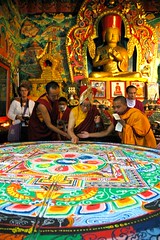
HH Dagchen Sakya Rinpoche Closing the Hevajra Mandala Lam Dre Tharlam Monastery Boudha Nepal
Originally uploaded by Wonderlane
The term is of Hindu origin and appears in the Rig Veda as the name of the sections of the work, but is also used in other Indian religions, particularly Buddhism.
In the Tibetan branch of Vajrayana Buddhism, mandalas have been developed into sandpainting.
Japanese Stone Lantern typically found in gardens and shrines
The stone lantern was introduced to Japan at the same time as Buddhism, in the 6th century, says thejapaneseconnection.com.
The ishidoro (literally "stone lantern") is the most common type, gracing gardens, temples and shrines throughout Japan even today.
Typically made of granite or syenite, ishidoro come in many different sizes and shapes, but common to them all is a hollowed upper part, made to hold electric lights, candles, or oil lamps, lighted on special occasions.
The 2,000 ishidoro that line the approach to the Kasuga Shrine in Nara (see below photo) are perhaps the most well-known in Japan. They are lighted twice a year, for the lantern festivals held in February and August.
Secular use of the ishidoro did not begin in Japan until the 16th century, when tea ceremony masters began to use them to decorate their tea gardens. Today Ishidoro are a common feature of many private gardens throughout Japan. Sanskrit letters or Buddhist icons/scriptures are typically engraved on the ishidoro.
The ishidoro (literally "stone lantern") is the most common type, gracing gardens, temples and shrines throughout Japan even today.
Typically made of granite or syenite, ishidoro come in many different sizes and shapes, but common to them all is a hollowed upper part, made to hold electric lights, candles, or oil lamps, lighted on special occasions.
The 2,000 ishidoro that line the approach to the Kasuga Shrine in Nara (see below photo) are perhaps the most well-known in Japan. They are lighted twice a year, for the lantern festivals held in February and August.
Secular use of the ishidoro did not begin in Japan until the 16th century, when tea ceremony masters began to use them to decorate their tea gardens. Today Ishidoro are a common feature of many private gardens throughout Japan. Sanskrit letters or Buddhist icons/scriptures are typically engraved on the ishidoro.
Buddhism: the eight-spoked wheel is a symbol of the eight paths to enlightenment
Buddhism is based on The Four Noble Truths, says thebigview.com:
1. Life means suffering.
- To live means to suffer, because the human nature is not perfect and neither is the world we live in. During our lifetime, we inevitably have to endure physical suffering such as pain, sickness, injury, tiredness, old age, and eventually death; and we have to endure psychological suffering like sadness, fear, frustration, disappointment, and depression.
2. The origin of suffering is attachment (or craving).
- The reasons for suffering are desire, passion, ardour, pursuit of wealth and prestige, striving for fame and popularity, or in short: craving and clinging. Because the objects of our attachment are transient, their loss is inevitable, thus suffering will necessarily follow. Objects of attachment also include the idea of a "self" which is a delusion, because there is no abiding self. What we call "self" is just an imagined entity, and we are merely a part of the ceaseless becoming of the universe.
3. The cessation (stopping) of suffering is attainable.
- The cessation of suffering can be attained through nirodha. Nirodha means the unmaking of sensual craving and conceptual attachment. The third noble truth expresses the idea that suffering can be ended by attaining dispassion. Nirodha extinguishes all forms of clinging and attachment.
4. The path to nirvana and the cessation of suffering is through 8 ways of correct living.
- The path to the end of suffering is a gradual path of self-improvement. It is the middle way between the two extremes of excessive self-indulgence (hedonism) and excessive self-mortification (asceticism); and it leads to the end of the cycle of rebirth.
1. Life means suffering.
- To live means to suffer, because the human nature is not perfect and neither is the world we live in. During our lifetime, we inevitably have to endure physical suffering such as pain, sickness, injury, tiredness, old age, and eventually death; and we have to endure psychological suffering like sadness, fear, frustration, disappointment, and depression.
2. The origin of suffering is attachment (or craving).
- The reasons for suffering are desire, passion, ardour, pursuit of wealth and prestige, striving for fame and popularity, or in short: craving and clinging. Because the objects of our attachment are transient, their loss is inevitable, thus suffering will necessarily follow. Objects of attachment also include the idea of a "self" which is a delusion, because there is no abiding self. What we call "self" is just an imagined entity, and we are merely a part of the ceaseless becoming of the universe.
3. The cessation (stopping) of suffering is attainable.
- The cessation of suffering can be attained through nirodha. Nirodha means the unmaking of sensual craving and conceptual attachment. The third noble truth expresses the idea that suffering can be ended by attaining dispassion. Nirodha extinguishes all forms of clinging and attachment.
4. The path to nirvana and the cessation of suffering is through 8 ways of correct living.
- The path to the end of suffering is a gradual path of self-improvement. It is the middle way between the two extremes of excessive self-indulgence (hedonism) and excessive self-mortification (asceticism); and it leads to the end of the cycle of rebirth.
Sunday, May 02, 2010
British Petroleum Deepwater Horizon oil spill location and description
One official source of news of the oil spill is at the BP Spill Response site.
Background, based upon the NY Times, National Public Radio and the BP Spill site:
- Off-shore well platform exploded, killing 11.
- The shut-off valve that was supposed to keep the ocean safe from an oil spill after an explosion did not work.
- Because the well is 5000 ft under water, evaluating the spill has been difficult.
- The well is about 50 miles SE of the Mississippi River delta.
- At risk is Louisiana's a) marsh lands b) fish, animals and birds that spawn and inhabit the marshes c) the fishermen who bring the coastal shrimp, fish and oysters to market.
- the oil slick is also moving toward the coast of Alabama (Mobile Bay, Gulf Shores, Dauphin Island, etc) and Florida (Pensacola, Destin, Seaside, etc).
- British Petroleum (BP) is trying a) put a steel & concrete cap on the well b) drill an adjacent well which would control the broken well.
- BP has hired fishermen to use their vessels in oil clean-up operations.
- Gulf currents are such ( see the Gulf Stream) that the spill may drift eastward - bringing more petroleum pollution to the coast of Florida.
Background, based upon the NY Times, National Public Radio and the BP Spill site:
- Off-shore well platform exploded, killing 11.
- The shut-off valve that was supposed to keep the ocean safe from an oil spill after an explosion did not work.
- Because the well is 5000 ft under water, evaluating the spill has been difficult.
- The well is about 50 miles SE of the Mississippi River delta.
- At risk is Louisiana's a) marsh lands b) fish, animals and birds that spawn and inhabit the marshes c) the fishermen who bring the coastal shrimp, fish and oysters to market.
- the oil slick is also moving toward the coast of Alabama (Mobile Bay, Gulf Shores, Dauphin Island, etc) and Florida (Pensacola, Destin, Seaside, etc).
- British Petroleum (BP) is trying a) put a steel & concrete cap on the well b) drill an adjacent well which would control the broken well.
- BP has hired fishermen to use their vessels in oil clean-up operations.
- Gulf currents are such ( see the Gulf Stream) that the spill may drift eastward - bringing more petroleum pollution to the coast of Florida.
Would you like to construct a Japanese mini dry landscape garden? Indie work . . .
Indie work takes an unusual turn:
- Get some wood, glue and sand and construct a shallow tray which will become a Japanese Rock Garden.
Any size will do. It may be square or rectangular. I've got one which is 4" X 15" and sits easily on a shelf yet is very satisfying when the sand is being raked.
You can assemble the wood pieces using tiny nails or white glue.
The bottom of the tray may be made of light cardboard.
The sand may be fine or coarse. You may use pea gravel if you have built a larger tray.
We will be making the simple wooden rake out of pieces of chopsticks in class on Tues. The in-class model will be very basic. You may want to make a nicer one to go with the rock garden tray.
- up to 10 pts.
- An illustrated flyer containing basic info will be posted on campus alongside the Japanese Rock Garden project.
- Japanese gardens
- Zen Buddhism (or just Buddhism)
- map of Japan
- up to 6 pts.
- Get some wood, glue and sand and construct a shallow tray which will become a Japanese Rock Garden.
Any size will do. It may be square or rectangular. I've got one which is 4" X 15" and sits easily on a shelf yet is very satisfying when the sand is being raked.
You can assemble the wood pieces using tiny nails or white glue.
The bottom of the tray may be made of light cardboard.
The sand may be fine or coarse. You may use pea gravel if you have built a larger tray.
We will be making the simple wooden rake out of pieces of chopsticks in class on Tues. The in-class model will be very basic. You may want to make a nicer one to go with the rock garden tray.
- up to 10 pts.
- An illustrated flyer containing basic info will be posted on campus alongside the Japanese Rock Garden project.
- Japanese gardens
- Zen Buddhism (or just Buddhism)
- map of Japan
- up to 6 pts.
Saturday, May 01, 2010
Japanese mini dry landscape garden
Karesansui 枯山水 (dry landscape gardens, also known as rock gardens and waterless stream gardens) are typically associated with Zen Buddhism, and often found in the front or rear gardens at the residences (houjou 方丈) of Zen abbots.
The main elements of karesansui are rocks and sand, with the sea symbolized not by water but by sand raked in patterns that suggest rippling water.
Representative examples are the gardens of Ryoanji Temple in Kyoto.
The main elements of karesansui are rocks and sand, with the sea symbolized not by water but by sand raked in patterns that suggest rippling water.
Representative examples are the gardens of Ryoanji Temple in Kyoto.
Indie work: seeing parallells in the histories of Yamaha and Honda
Two of the world's great companies, Yamaha and Honda have fascinating and long histories.
The Honda Cub motorbike remains a workhorse vehicle worldwide.
The Honda Cub motorbike remains a workhorse vehicle worldwide.
Subscribe to:
Comments (Atom)

